It seems we can’t find what you’re looking for. Perhaps searching can help.
Sign Up for newsletter!
Subscribe to get the latest eBook!
Hotline



 40
40
 6,017
6,017
 0
0
 24
24
 2
2
 13,633
13,633
 0
0
 1
1
 2
2
 13,569
13,569
 0
0
 1
1
 2
2
 13,456
13,456
 0
0
 1
1
 2
2
 13,267
13,267
 0
0
 1
1




Headless Commerce is a significant revolution in the technology sector, changing the way businesses approach eCommerce. In this field, Adobe Commerce leads in providing solutions and tools for implementing Headless Commerce.
Below is a list of 10 well-known brands currently utilizing Adobe Commerce and Headless Commerce.
Samsung is a multinational conglomerate based in South Korea, operating in various sectors, with its most prominent being consumer electronics, generating a revenue of $234 billion in 2022.

Samsung’s eCommerce website is built on the Adobe Commerce Cloud platform, utilizing Headless Commerce technology as its core. Thanks to this, Samsung has developed a virtual assistant to support customers in online and in-store shopping. In the U.S. market, customers can use this assistant to view product demos, receive usage instructions, and make online purchases. Customers have highly praised this feature for providing a more comfortable and convenient shopping experience.
Target Corporation is a major retail company in the United States, offering a wide range of products and services, including clothing, footwear, electronics, household goods, toys, and furniture. According to the financial report of Target Corporation in 2022, the revenue reached $106.8 billion, a growth of 8.4% compared to 2021.

Target recognized that the brand was losing revenue as customers began their shopping journey on one device and ended it on another. The retailer has implemented Headless Commerce to deploy omnichannel sales to increase conversion rates on various devices, thereby making it easier for customers to complete their purchase transactions.
Toyota is one of the largest automobile manufacturers in the world, selling over 10 million vehicles globally each year. Toyota produces a variety of vehicles and accessories, including cars, trucks, buses, and sports utility vehicles, as well as engines, transmissions, and auto parts.

Toyota’s website utilizes Headless Commerce to leverage Application Programming Interfaces (APIs) for integration with legacy systems and inventory management, providing a personalized omnichannel experience.
Under Armour is an American sportswear company founded in 1996 by Kevin Plank. The company is headquartered in Baltimore, Maryland, and specializes in the production of sportswear, footwear, and accessories, with an annual revenue of over $10 billion.

Currently, Under Armour is using Headless Commerce to enhance the personalized fitness experience based on location, purchase history, and workout activities, as well as training logs. The Under Armour website features notable functionalities such as inventory alerts, traffic history, payment information, and content management using data from the order management system.
Kirkland’s is a chain of home décor, furniture, textiles, accessories, and gift stores in the United States. The company is headquartered in Brentwood, Tennessee, and operates 431 stores in 35 states and an eCommerce website.

Kirkland’s has implemented Headless Commerce to address website-related issues such as flexibility, custom design, and providing a smooth shopping experience (single-click login and biometric payment capabilities).
Coca-Cola is a carbonated beverage brand established in 1886. It is currently the world’s best-selling beverage brand, available in over 200 countries and territories, with over 2 billion cans sold every day.

The Coca-Cola website utilizes Headless Commerce technology to leverage API integration, providing a seamless end-to-end omnichannel experience for global customers. This technology allows the business to expand through its markets, customize experiences, and integrate with third-party suppliers and solutions.
Technodom is one of the largest retailers in Central Asia, with an annual revenue of $800 million. This retail giant has around 9,000 employees, offering over 60,000 products and 4,000 categories.

Technodom has implemented Headless Commerce on Magento with a page load speed of under one second, thanks to the PWA (Progressive Web App) pre-rendering solution. Additionally, the website’s backend is integrated with Akeneo PIM (Product Information Management) and ESB (Enterprise Service Bus), essential components for businesses to efficiently manage and distribute their databases.
Helly Hansen is a renowned Norwegian company that manufactures and retails clothing, sports gear, and outdoor accessories. Established in 1877, the company is now one of the world’s leading fashion and lifestyle brands, with a revenue of $2.8 billion in 2022.
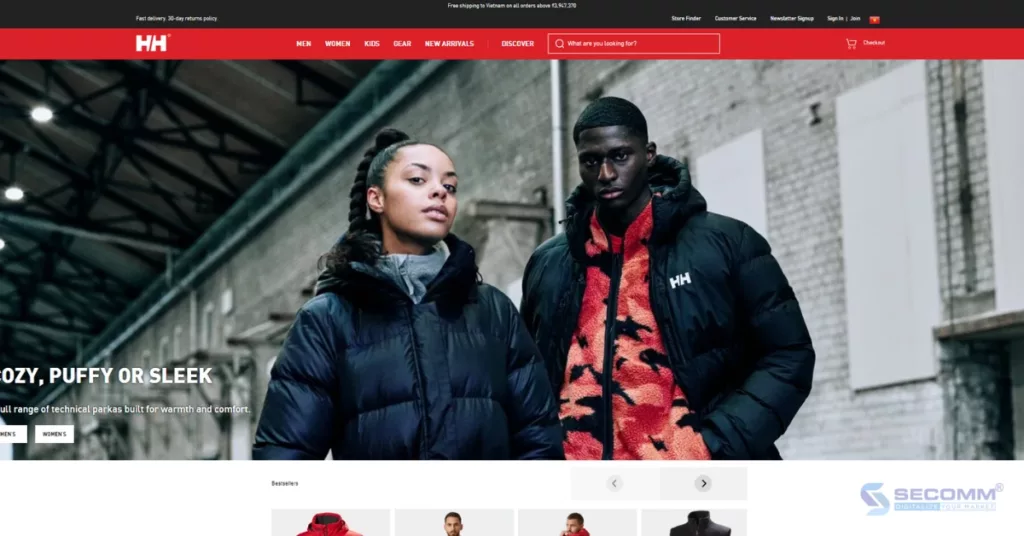
Initially, Helly Hansen’s eCommerce website was built on the Magento platform. After a period of business operations, Helly Hansen decided to transition to Adobe Commerce to implement Headless Commerce. As a result, Helly Hansen’s website quickly saw a 24% increase in traffic, a 48% increase in mobile traffic, and a more than 45% increase in total revenue.
Kaporal is a French fashion brand specializing in jeans, T-shirts, shirts, jackets, and accessories. The brand was established in 2004 and is currently present in over 30 countries worldwide.

Similar to many longstanding Magento businesses, Kaporal has migrated its platform from Magento 1 to Magento 2 to take advantage of the Headless Commerce features from PWA Studio, addressing issues related to slow speed and poor mobile performance.
G-SP is a brand specializing in the business of spare parts and digital accessories, established in 2009. This Swedish company currently has offices in Sweden, the Netherlands, and China, offering over 10,000 products.

Similar to many other Magento stores, G-SP faced issues with website performance and stability. Therefore, G-SP opted for Headless PWA to enhance their digital conversions. The implementation of Headless PWA accelerated the mobile website speed by 2.7 times, which is particularly crucial for a complex Magento website with numerous plugins and categories like G-SP.
Above is the list of the top 10 eCommerce websites currently using the Adobe Commerce (Magento) eCommerce platform and Headless Commerce globally.
With deep expertise and the development of complex eCommerce systems for clients such as Changi Airport Group (Singapore), Trentham Estate (Australia), and The Warehouse (Vietnam), SECOMM understands the challenges in choosing a platform and deploying eCommerce that businesses are facing.
Contact SECOMM now or call directly at the hotline number (028 7108 9908) for free advice on the eCommerce website building roadmap!
 2
2
 3,337
3,337
 0
0
 1
1
Magento and Adobe Commerce are considered popular eCommerce platforms, used by hundreds of thousands of businesses worldwide.
Both platforms have strong growth potential in the future, given the increasing trend of eCommerce and the demand for robust and flexible eCommerce solutions.
Magento is an open-source eCommerce platform used by over 300,000 eCommerce websites before being officially acquired by Adobe in 2018. Magento is known for its performance, user-friendliness, scalability, and security, especially in Magento 2.0.
Since its establishment, Magento has provided two main versions for businesses:
Currently, there are two main versions:
Magento Open Source and Adobe Commerce. Adobe Commerce is further divided into two versions, On-Premise (referred to as Adobe Commerce) and On-Cloud (referred to as Adobe Commerce Cloud).
Magento Open Source is a free, open-source eCommerce platform that requires users to have technical knowledge and skills to install, build, and manage the website. This platform also takes time and money to deploy basic to advanced features.
Key features include:
Depending on the complexity of the system, the cost of deploying a Magento website can fluctuate around $50,000 for the first year.
This is a paid on-premises service from Adobe, so this platform includes all the premium features of Magento Open Source and more.
After merging with Adobe, Magento Commerce was renamed Adobe Commerce and is considered part of the Adobe Experience Cloud—a set of solutions designed to help businesses make informed decisions and provide enhanced customer experiences based on detailed information and data.
Adobe Commerce is often integrated with Adobe Experience Manager, Adobe Analytics, and Adobe Target. Through Adobe Commerce, businesses have access to smart business services provided by Adobe, as well as machine learning capabilities and personalization provided by Adobe Sensei.
This makes Adobe Commerce the perfect eCommerce platform for businesses with complex needs and a desire to leverage leading capabilities to provide superior experiences for customers across multiple devices and channels. However, due to the relatively complex functional eCommerce website system on Adobe Commerce, businesses will need to be autonomous in the complex infrastructure as well.
The following diagram illustrates the reference architecture for deploying Adobe Commerce on AWS infrastructure. Other cloud service providers such as Azure, Google Cloud, and Alibaba Cloud also have similar infrastructure designs and services.

With all the reasons mentioned above, Adobe Commerce will have relatively high deployment costs, around $130,000 per project for the first year, depending on the complexity of the website system.
In contrast to the self-hosted version like Adobe Commerce, Adobe Commerce Cloud is a version that includes cloud services.
Specifically, this platform includes all the features of Adobe Commerce along with enhanced Adobe Cloud infrastructure, including integrated GIT (distributed source code management software) and specific environments for development, staging, and building the website system.
This means that developers using this platform can write code, test, and deploy on suitable environments, ensuring smooth performance.

Similar to Adobe Commerce, Adobe Commerce Cloud is also suitable for large enterprises with special requirements because this version can meet all specialized needs, with flexibility and scalability through available management features.
However, the cost for enterprises to deploy Adobe Commerce Cloud will be higher than Adobe Commerce, around $150,000 per project for the first year, depending on the complexity of the website system.
Read more: The cost of building an Adobe Commerce (Magento) website
Although Adobe Commerce and Magento share the same core technology platform, they have functional differences. Magento includes some core features, and businesses can develop or integrate additional features through extensions.
On the other hand, Adobe Commerce includes features from Magento Open Source, along with additional features developed by the Adobe team.
Similarly, Adobe Commerce Cloud includes features from Adobe Commerce, along with advanced and more specialized features designed to address specific challenges for each business.

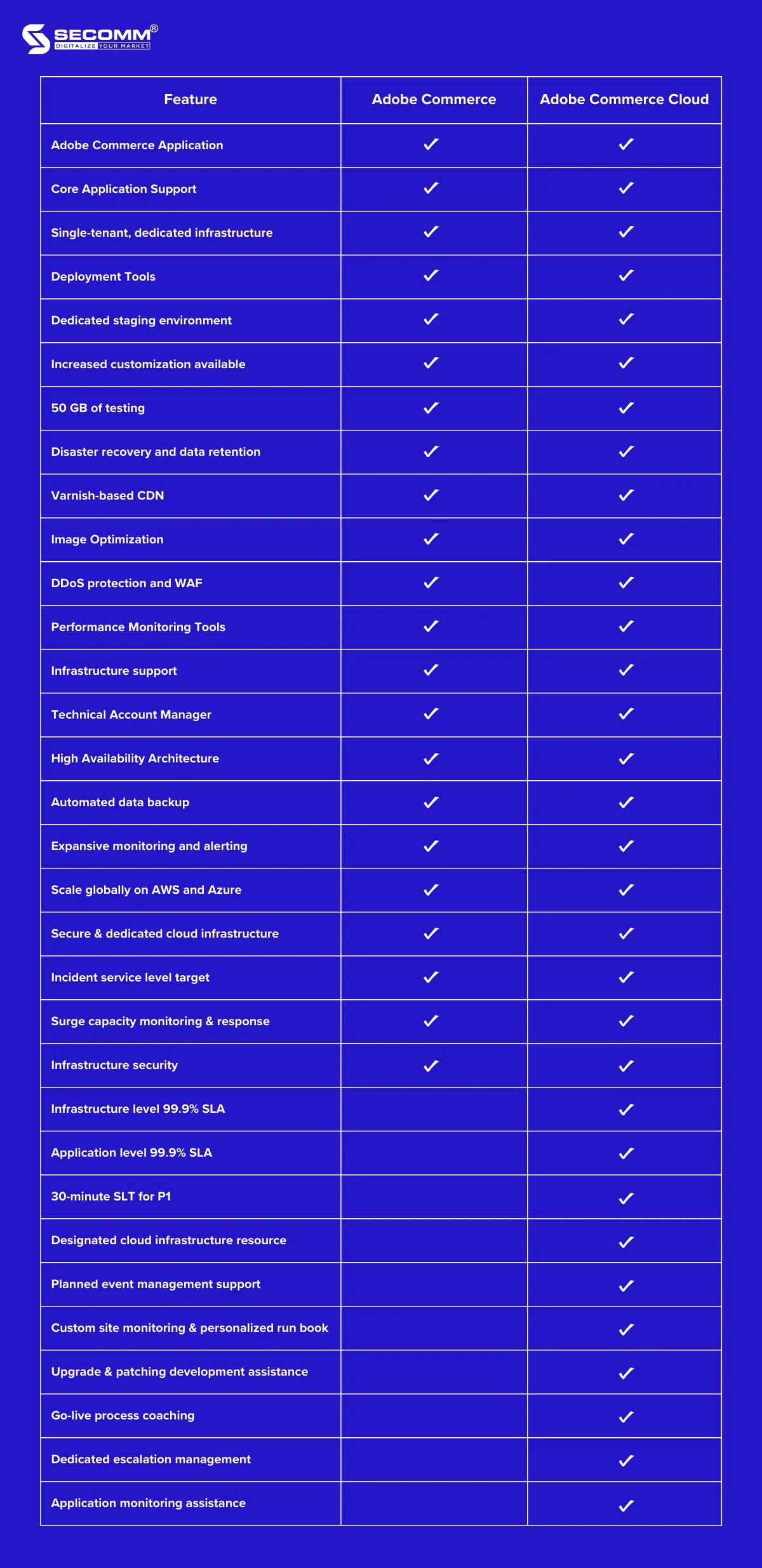
Besides the features, Magento and Adobe Commerce (both versions) also have some other differences.

Magento and Adobe Commerce are both powerful eCommerce platforms that can meet the needs of businesses of all sizes. However, there are some notable differences between these two platforms.
Choosing the right eCommerce platform for a brand depends on the specific needs and budget of each business. If a business is a small to medium-sized enterprise, newly entering the market, and only requires basic and advanced features, then Magento Open Source is a good choice.
However, if the business is large and complex, requiring extensive features and scalability, then Adobe Commerce is a better choice.
With deep expertise and the development of complex eCommerce systems for clients such as Changi Airport Group (Singapore), Trentham Estate (Australia), and The Warehouse (Vietnam), SECOMM understands the challenges in choosing a platform and deploying eCommerce that businesses are facing.
Contact SECOMM now or call directly at the hotline number (028 7108 9908) for free advice on the eCommerce website building roadmap!
Read more:
 8
8
 6,382
6,382
 0
0
 1
1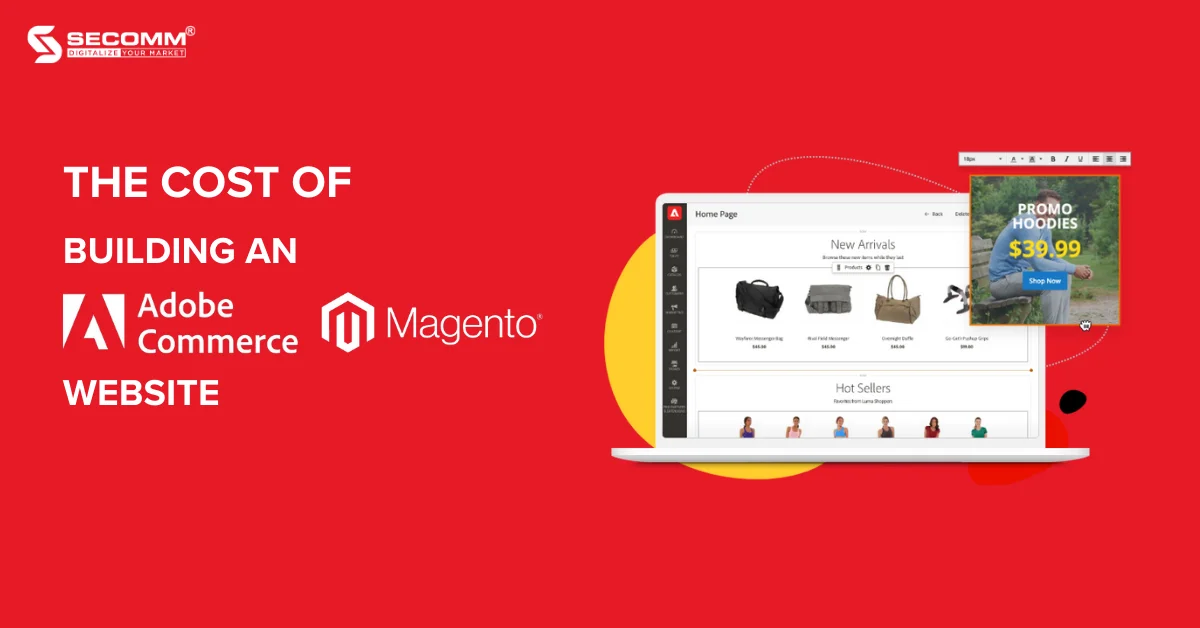
Adobe Commerce (Magento) is a powerful and feature-rich eCommerce platform that can help businesses build and operate professional eCommerce websites.
Therefore, Adobe Commerce is trusted by many businesses, especially medium to large enterprises, with over 100,000 websites, including the Magento Open Source version (According to Builtwith).
So, what is the cost to build a website on Adobe Commerce (Magento)?
Adobe Commerce is an open-source eCommerce platform designed specifically to cater to medium to large-scale businesses, offering high customization and scalability.
Formerly known as Magento Commerce, it was founded in 2007 in Culver City, California, USA. After several changes in ownership, in 2018, Adobe acquired Magento for $1.68 billion and rebranded it as Adobe Commerce.
Today, Adobe Commerce has become an integral part of the Adobe Experience Cloud, a suite of products and services designed to help businesses build, manage, and deliver digital experiences.
Currently, Adobe Commerce has two main versions: Adobe Commerce Cloud and Magento Open Source.
Magento Open Source (referred to as Magento) is a free version that can be downloaded and used by anyone. This version provides essential functions for creating and managing online stores, including:
However, businesses using the free Magento version do not necessarily mean that the cost of building an eCommerce website will be low, as additional costs need to be considered by the business.

Depending on the complexity of the system, the cost to deploy a Magento website can be lower or higher than $60,000 for the first year.
Read more: The Significant Differences between Magento 1 and Magento 2
Formerly known as Magento Enterprise Edition (EE) or Magento Commerce On-Premise (On-Prem), Adobe Commerce is an enterprise-level option that doesn’t require businesses to manage performance or hosting.
Adobe Commerce is specifically designed for businesses engaged in more complex eCommerce operations, fully supported by Adobe’s technically skilled team. Its built-in features provide businesses with more control without the need for integrating many extensions, as seen in Magento Open Source.
Key features of Adobe Commerce include:
Below is the licensing fee table for Adobe Commerce for businesses based on annual revenue.

In addition to the license usage fee, businesses need to independently manage other fees such as hosting, domain, interface, website development, extensions, and system maintenance. Therefore, the cost to implement Adobe Commerce will be relatively high, around $130,000 per project for the first year, depending on the complexity of the website system.
Related article: Magento Open Source vs Magento Commerce Real Comparison
Adobe Commerce Cloud is a free version that includes hosting services, technical support specialists, and specialized features to build and operate successful online stores.
The most significant highlight of Adobe Commerce Cloud is the hosting service built on AWS cloud servers and performance monitoring tools such as New Relic and Blackfire.io, reducing additional costs and providing optimal performance for the website system.

Another advantage of Adobe Commerce Cloud is that businesses don’t need to take responsibility for serious issues; all incidents are handled directly by Adobe’s personnel.
Furthermore, the functionality of Adobe Commerce Cloud is also rated higher than Adobe Commerce On-Premise.
| Feature | Adobe Commerce | Adobe Commerce Cloud |
| Adobe Commerce Application | ✔ | ✔ |
| Core Application Support | ✔ | ✔ |
| Single-tenant, dedicated infrastructure | ✔ | ✔ |
| Deployment Tools | ✔ | ✔ |
| Dedicated staging environment | ✔ | ✔ |
| Increased customization available | ✔ | ✔ |
50 GB of testing | ✔ | ✔ |
| Disaster recovery and data retention | ✔ | ✔ |
| Varnish-based CDN | ✔ | ✔ |
| Image Optimization | ✔ | ✔ |
DDoS protection and WAF | ✔ | ✔ |
| Performance Monitoring Tools | ✔ | ✔ |
| Infrastructure support | ✔ | ✔ |
Technical Account Manager | ✔ | ✔ |
| High Availability Architecture | ✔ | ✔ |
Automated data backup | ✔ | ✔ |
| Expansive monitoring and alerting | ✔ | ✔ |
| Scale globally on AWS and Azure | ✔ | ✔ |
| Secure & dedicated cloud infrastructure | ✔ | ✔ |
| Incident service level target | ✔ | ✔ |
Surge capacity monitoring & response | ✔ | ✔ |
| Infrastructure security | ✔ | ✔ |
| Infrastructure level 99.9% SLA | ✔ | ✔ |
| Application level 99.9% SLA | ✔ | |
| 30-minute SLT for P1 | ✔ | |
| Designated cloud infrastructure resource | ✔ | |
| Planned event management support | ✔ | |
| Custom site monitoring & personalized run book | ✔ | |
| Upgrade & patching development assistance | ✔ | |
| Go-live process coaching | ✔ | |
| Dedicated escalation management | ✔ | |
Application monitoring assistance | ✔ |
Source: Adobe Commerce Pricing
Here is the licensing fee table for using Adobe Commerce Cloud for businesses based on annual revenue.

For the On-Cloud version, businesses also need to consider additional costs such as domain, interface, website development, and extensions. The cost to complete an Adobe Commerce Cloud website will be around $150,000/project for the first year, depending on the complexity of the website system.
In general, Adobe Commerce (Magento) is a perfect choice for large businesses with high feature requirements, so the cost of building an eCommerce website on this platform will be relatively high compared to other eCommerce platforms.
However, finding the best-suited platform will depend on various factors such as strategic models, business scale, deployment time, and budget.
With deep expertise and the development of complex eCommerce systems for clients such as Changi Airport Group (Singapore), Trentham Estate (Australia), and The Warehouse (Vietnam), SECOMM understands the challenges in choosing a platform and deploying eCommerce that businesses are facing.
Contact SECOMM now or call directly at the hotline number (028 7108 9908) for free advice on the eCommerce website building roadmap!
Related article:
 2
2
 7,436
7,436
 0
0
 1
1
Among the eCommerce platforms that businesses consider choosing to develop their online stores, the two names Adobe Commerce and WooCommerce are always put on the scale for comparison.
Both are suitable for small and large businesses to build websites due to their flexible customization capabilities and high scalability. However, there are significant differences between WooCommerce and Adobe Commerce that are worth noting.
Adobe Commerce, formerly known as Magento Commerce, is an open-source eCommerce solution designed for medium to large-scale businesses, particularly those undergoing rapid growth and with high demands for customization and scalability.

Currently, Adobe Commerce offers two different version options:
Related article: Top 20 eCommerce websites using Adobe Commerce (Magento)
WooCommerce is an open-source eCommerce plugin developed for the WordPress platform, a widely used Content Management System (CMS) for creating and managing websites.

Consequently, WooCommerce is favoured by many businesses utilizing WordPress to develop their eCommerce websites.
Related article: Top 20 eCommerce websites using WooCommerce
Adobe Commerce and WooCommerce are two popular eCommerce platforms, but each platform serves different business needs due to differences in deployment costs, feature systems, scalability, and security.
The deployment costs of Adobe Commerce will depend largely on the version chosen by the business.

It can be seen that the deployment cost for an eCommerce website on Adobe Commerce is relatively high, starting from $15,000 per project for the Magento version and $130,000 per project for the first year with the Adobe Commerce version.
In contrast, the cost of using WooCommerce is entirely free, and the website construction cost is also relatively more budget-friendly compared to Adobe Commerce. Below are some estimated costs for deploying an eCommerce website on WooCommerce:

Note: These are only cost estimates. Actual costs may vary depending on factors such as needs, service providers, and optional features.
Adobe Commerce and WooCommerce are both comprehensive eCommerce platforms covering everything from A to Z. Both have their advantages and disadvantages, catering to the diverse functional needs of businesses.

In addition to the basic feature set, businesses also need to consider advanced features that the system can accommodate.
It can be seen that the feature system of Adobe Commerce is more comprehensive than WooCommerce, covering both basic and advanced functionalities.
Therefore, for small to medium-sized businesses just starting in eCommerce, WooCommerce is a suitable choice. If the brand is a large enterprise with the need to build a large, complex online store, Adobe Commerce would be a perfect choice.
Read more: Top 10 Features To Increase eCommerce Website Revenue
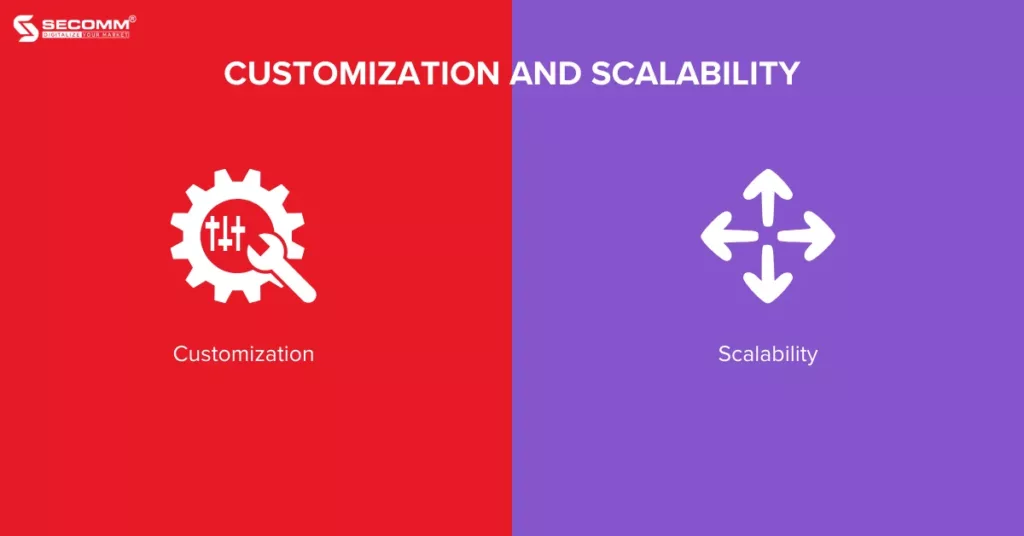
Adobe Commerce is an open-source platform, especially the Magento Open Source version, meaning developers can access the source code, making customization easier. This allows businesses to create features and integrate customizations to meet specific needs.
Similarly, WooCommerce also provides high customization capability with numerous available themes, plugins, and apps.
However, as a WordPress plugin, WooCommerce’s customization capability is not as extensive as Adobe Commerce.
Both platforms have high scalability to handle traffic and large transaction volumes. However, Adobe Commerce’s scalability is higher than WooCommerce’s, especially for businesses with large, complex product catalogues or significant inventory management needs.
In summary, Adobe Commerce offers higher customization and scalability capabilities compared to WooCommerce. Still, the website development process with Adobe Commerce is more complex, requiring developers with substantial experience and technical expertise.
Adobe Commerce and WooCommerce both provide features and tools for securing customer and business data. However, there are some notable differences in security capabilities between these two platforms.

Adobe Commerce offers a range of security features and tools, including:
WooCommerce also provides some security features and tools, including:
Similar to the above factors, Adobe Commerce is generally considered to have higher security compared to WooCommerce.
It can be seen that Adobe Commerce is rated higher than WooCommerce in many aspects. However, while WooCommerce is known for being a user-friendly platform, making it easy for businesses without strong technical capabilities to quickly deploy, Adobe Commerce requires a professional team to build and manage a highly customized, scalable, and complex system.
In general, WooCommerce is suitable for small to large businesses using WordPress, wanting to start e-commerce deployment, and requiring basic customization and expansion solutions. However, Adobe Commerce offers flexibility, customization, and scalability, making it more suitable for corporations with complex system requirements.
In reality, the more flexible and customizable platforms with high scalability, the more complex and costly the deployment process becomes. Therefore, businesses need to consider the scale and development needs to make an appropriate choice.
With deep expertise and the development of complex eCommerce systems for clients such as Changi Airport Group (Singapore), Trentham Estate (Australia), and The Warehouse (Vietnam), SECOMM understands the challenges in choosing a platform and deploying eCommerce that businesses are facing.
Contact SECOMM now or call directly at the hotline number (028 7108 9908) for free advice on the eCommerce website building roadmap!
Read more: Shopify Plus vs Adobe Commerce: Key Differences 2023
 2
2
 6,311
6,311
 0
0
 1
1
Adobe Commerce is an open-source eCommerce platform designed specifically for businesses ranging from medium to very large scales with high growth and significant customization and scalability needs.
Adobe Commerce has two versions, including:
According to reports from W3Techs and Adobe Commerce, as of July 2023, there are a total of over 367,000 eCommerce websites using Magento and Adobe Commerce. Among them, Magento holds about 5% of the global eCommerce market share, and Adobe Commerce holds about 3% of the global eCommerce market share.
See more: What is Adobe Commerce? Should we use Adobe Commerce?
Here is a list of 10 famous international brands and 10 famous brands in Vietnam currently using Adobe Commerce.
HP is a multinational IT company based in Palo Alto, California, specializing in the development of personal computers, printers, and related supplies, as well as 3D printing solutions.

HP deployed its first Magento Open Source 1 (formerly known as Magento Commerce) website in Thailand and Indonesia in 2013. When opening stores in China, they decided to switch to the Adobe Commerce version to support customers searching for products globally.
With Adobe Commerce, HP can further optimize the shopping experience and implement new features more quickly, helping the business achieve its eCommerce goals.
ASUS is an abbreviation for Asus Software Unit Systems, a multinational conglomerate headquartered in Taiwan, specializing in the manufacturing of electronic products and computer hardware. ASUS was founded in 1989 and is currently one of the world’s largest computer manufacturers.

ASUS aimed to have a unified platform for both B2B and B2C eCommerce, so the business chose Adobe Commerce for its flexibility in integration, high customization, and streamlining of support processes.
Hydro Flask is a brand of thermal flasks and water bottles established in 2009 in Seattle, Washington, USA. The brand is known for its high-quality, well-insulated, and visually appealing products.

Hydro Flask utilized Magento Open Source to build and develop its eCommerce website due to its ability to provide the necessary features and functionalities.
Filson is an outdoor gear manufacturing company based in Seattle, Washington, USA. The company was established in 1897 by Charles Filson, a tailor and cobbler. Filson specializes in producing high-quality, durable products designed for outdoor activities such as camping, fishing, hiking, etc.

In 2022, Filson adopted Magento 2 to build its eCommerce website. With the microservices architecture of Magento 2, Filson can easily customize and scale its eCommerce website as needed.
Alshaya is one of the major franchise operators globally, managing brands such as American Eagle Outfitters, H&M, Debenhams, Victoria’s Secret, Bath & Body Works, The Body Shop, Boots, and M.A.C in the United Arab Emirates (UAE). As shopping habits began to change, Alshaya gradually shifted towards developing its eCommerce sector and decided to choose Adobe Commerce to build its website in 2017.

“Thankfully, when COVID-19 hit, we had already built up the digital framework to launch new websites quickly. And because we had built our approach on the Adobe Commerce global reference architecture, we were able to leverage parent configurations rather than building new sites from scratch. With IT complexity removed from the equation, we were able to roll out the new sites in a matter of weeks.” – Marc van der Heijden, Chief Technology Officer, Alshaya Group.
Catbird is a high-end jewelry brand established in 2004 in New York City, USA. The brand is known for its delicate and artistic designs. Catbird’s products are crafted from various materials, including gold, silver, gemstones, etc.

Catbird has utilized Adobe Commerce to build custom functionalities for the jewelry eCommerce industry, including notifications for available, and out-of-stock items, and advance delivery notices to ensure customers can view complete inventory. According to Ali Ahmed, the Founder of Imagination Media, “Like Catbird, Adobe Commerce is a truly robust, dazzling, and creative platform that allows us to build and create basically whatever we want because it is open and extensible”.
DKNY, short for Donna Karan New York, is a high-end fashion and apparel brand founded by designer Donna Karan in 1989. DKNY is known for its youthful, modern, and highly practical fashion products.

DKNY leveraged Magento to build its fashion eCommerce website in 2023. Thanks to the advantages of open source, DKNY prioritizes user interface personalization, showcasing its distinctive brand style, and providing advanced features such as intelligent product search, product previews, and product customization.
Ranking: 95,191 (US) & 173,066 (Global)
Volkswagen Classic Parts is a part of the Volkswagen Group, responsible for supplying genuine replacement parts for classic Volkswagen vehicles. Volkswagen Classic Parts is headquartered in Wolfsburg, Germany, and operates in over 100 countries worldwide.

The eCommerce website for Volkswagen parts features around 60,000 accessories, catering to the needs of both new and seasoned Volkswagen enthusiasts, bringing joy to fans of classic Volkswagen vehicles.
Initially, Volkswagen used Magento Commerce 1 for several years and reaped significant benefits from this open-source platform. Recently, Volkswagen Classic Parts decided to upgrade to Adobe Commerce and utilize Adobe Experience Manager to further develop the brand in the eCommerce market.
Laybyland is a ‘Buy Now, Pay Later’ retail business for consumer electronics established by Stuart Duff in 2012 in Australia. After two years of operation, Laybyland realized that the current CMS system using Drupal was not meeting the operational requirements and struggled to handle the growing data volume.

Therefore, Laybyland chose SECOMM to migrate the website to a robust eCommerce platform like Magento Open Source. With over 10 years of operation, thanks to a unique business strategy—the exclusive Lay-by payment process allowing customers to customize the time and frequency of instalments when shopping online—and a professionally controlled eCommerce system by SECOMM, Laybyland expanded the ‘Buy Now, Pay Later’ retail system to two other major markets, the United States and New Zealand.
“SECOMM’s technical expertise allowed us to successfully overcome these development challenges and deploy a website that has performed exactly as we wanted from day one.” – Stuart Duff, CEO at Laybyland
Covento is a young business in the renewable energy sector, operating in five countries: Denmark, Germany, Spain, the Netherlands, and France. At Covento, users can find the necessary spare parts/components for turbine models from various manufacturers and suppliers.

Jill Ashley Brandt, CEO of Covento, plans to leverage the continuous improvements of Adobe Commerce to make Covento more user-friendly for buyers and suppliers in the U.S. market, serving the goal of expanding the business.
Di Dong Viet is a reputable brand in the field of electronic devices and a strategic partner of global technology conglomerates such as Apple, Samsung, OPPO, Sony, ASUS, and more.

By using Magento Open Source, Di Dong Viet has successfully built a high-quality eCommerce website with features such as product management, shopping cart, online payment, order management, and various other extended features to create a convenient online shopping experience for customers.
CGV is one of the top 5 largest cinema chains globally and is a major film distributor and cinema chain in Vietnam, alongside Galaxy, Lotte Cinema, BHD Star Cineplex, and CineStar.

CGV has built an eCommerce website on the Magento Enterprise platform (the paid version of Magento, now known as Adobe Commerce) to meet the feature requirements suitable for large enterprises like CGV.
Established in 2009, Kids Plaza is a major player in the eCommerce race in the Baby industry. Kids Plaza has deployed an eCommerce website on the Magento platform to efficiently manage a diverse and extensive product portfolio. The brand regularly runs promotional programmes such as gift shopping promotions, flash sales, buy 5 get 1 free, and loyalty point accumulation for attractive rewards.

This has contributed significantly to the increase in website traffic on every promotional occasion, and deploying Magento can enhance customization and scalability to handle sudden traffic increases. On average, the website receives about 1 million visits per month.
Hoang Phuc International is a high-end fashion retailer for Kappa, Ecko Unltd, Superga, Replay, and Staple, established in 1989. After three decades of traditional business development, the brand decided to transition to participate in the eCommerce market.

To successfully develop the current eCommerce website, Hoang Phuc has used and converted many platforms. As of now, the business is using the Magento platform – an open-source eCommerce platform specializing in eCommerce.
Bach Long is one of the popular retailers of smartphones, tablets, and technology accessories in Vietnam. Similar to other consumer electronics retailers like CellphoneS, Di Dong Viet, Bach Long Mobile also chose the Magento platform to build their websites.

Therefore, the brand’s website has seen significant improvements in features, customization capabilities, and performance, helping the company attract more customers, grow its market share, and increase revenue and profits.
On Off is a lingerie brand established in 2005 with a mission to bring daily comfort to everyone.

On Off has chosen the Magento Open Source version, the free version of Magento, to build its eCommerce website to meet the company’s specific needs for features, customization capabilities, and system scalability.
EROPI is another prominent jewelry brand in Vietnam, specialising in distributing various types of gold, silver, jewelry, gemstones, pearls, wedding jewelry, and feng shui jewelry. After many years of operation, the company has not only expanded its chain of stores nationwide but also developed an online sales channel to meet the shopping needs of customers.

The primary online channel that EROPI focuses on is the eCommerce website built on the Magento Open Source platform with superior customization capabilities. This allows EROPI to develop advanced features and flexible scalability, ensuring the long-term development goals of the business.
At first, the company was established in 2006 under the name Uma Furniture Supermarket and officially changed its name to Baya Furniture and Decoration Supermarket in 2019. Despite the name change, the brand still retains its core values and brings customers high-quality furniture with simple, elegant designs, in line with contemporary trends, featuring neutral colours, and each piece having its own beauty.

As of the current time, Baya’s website attracts nearly 100,000 visits per month, thanks to the proper investment in building an eCommerce furniture website with the open-source Magento platform. The website features an attractive, captivating interface that is user-friendly.
Rohto is a well-known Japanese pharmaceutical and cosmetic brand established in 1899, specialising in manufacturing and selling eye care, skincare, lip care, hair care, cosmetics, pharmaceuticals, etc.

Rohto Vietnam’s eCommerce website is built on the Magento Enterprise version. Through Magento, the website is designed with an attractive and user-friendly interface, integrating features and customer support services to make shopping easier and more convenient.
Annam Gourmet, born out of a deep passion for European cuisine by the founders of the Annam Group, has been a strong player in the Vietnamese market for over 20 years. The Annam Gourmet store chain has expanded significantly, offering imported high-quality products such as premium food, wine, beverages, and cosmetics.
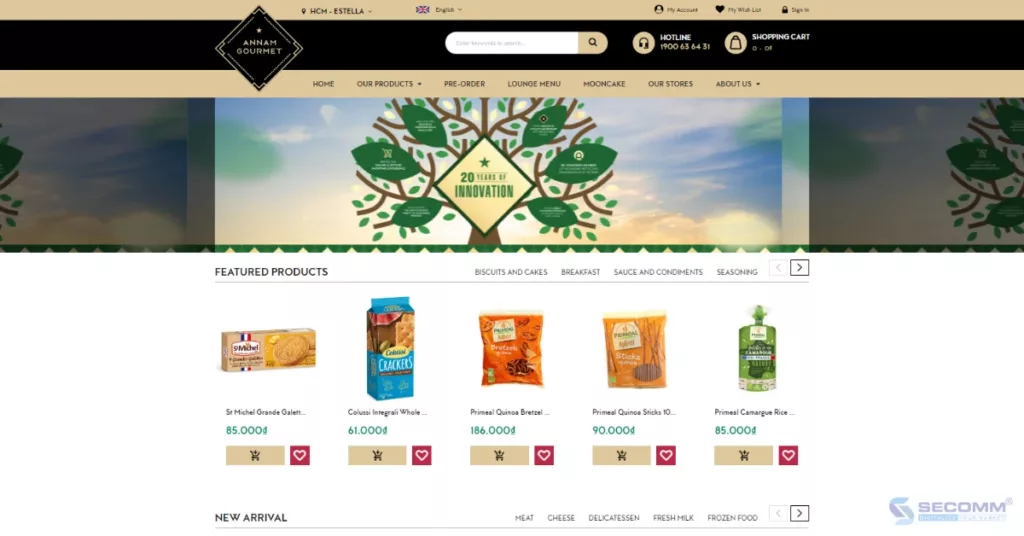
While Annam Gourmet had an existing online presence, it was primarily used for brand development, and the effectiveness of eCommerce was not a primary focus. To ensure the website is fully developed and operates smoothly, Annam Gourmet chose SECOMM and strategic partner Synova to develop the eCommerce website on the Magento Open Source 2 platform.
Here is a list of the top 20 eCommerce websites using the Adobe Commerce (Magento) eCommerce platform in both the international and Vietnamese markets.
With deep experience and the development of complex eCommerce systems for clients such as Changi Airport Group (Singapore), Trentham Estate (Australia), and The Warehouse (Vietnam), SECOMM understands the challenges in choosing a platform and implementing eCommerce that businesses are facing.
Contact SECOMM now or call directly on the hotline (028 7108 9908) for free advice on developing eCommerce on the Adobe Commerce (Magento) platform!
 2
2
 9,657
9,657
 0
0
 1
1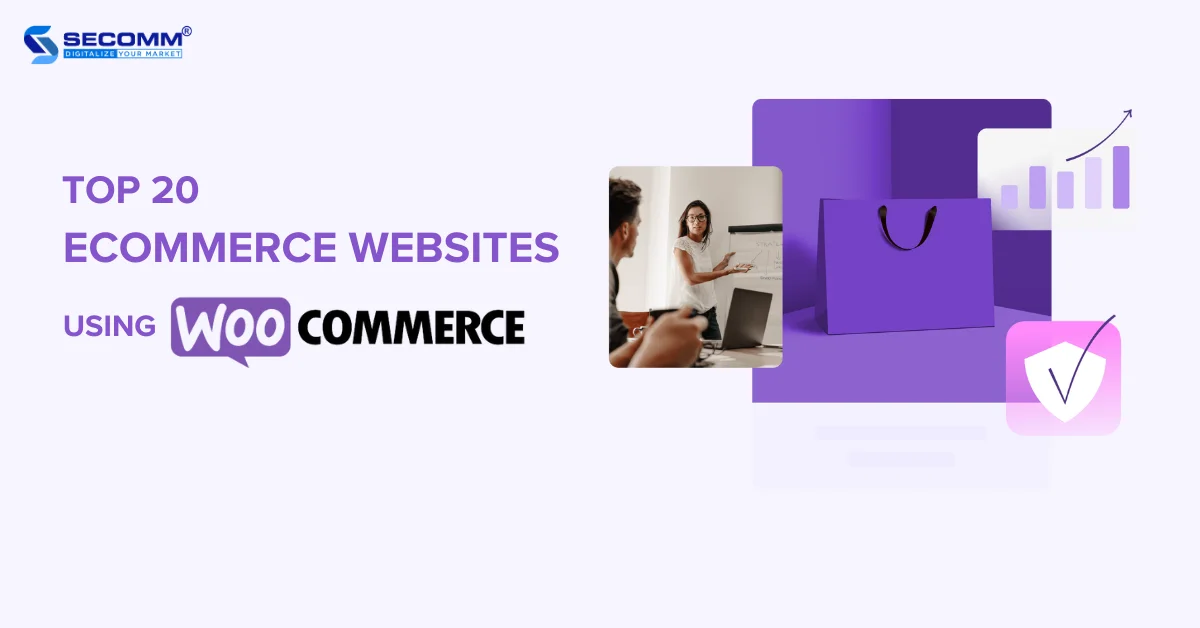
WooCommerce is an open-source plugin for WordPress, that enables businesses to turn their brand’s content website into an online store. According to WooCommerce’s report, as of July 2023, over 6 million eCommerce websites are using WooCommerce, capturing more than 25% of the global eCommerce market share.
Here are some well-known brands using WooCommerce in both the international and Vietnamese markets.
Established by Dr. William Mathias Scholl over 110 years ago, Dr. Scholl’s has become a trusted name in foot health care. The brand is known for various innovative products, from shoe insoles and foot-shaping tools to specialized treatment methods.

Despite being a globally renowned brand, Dr. Scholl’s continues to advance with strategies to maximize online sales. By utilizing the open-source eCommerce platform WooCommerce, Dr. Scholl’s has streamlined the process of building an eCommerce website and rationalized the online sales process.
Wienerschnitzel is the world’s largest hot dog chain, founded by John Galardi in 1961. Currently serving over 120 million hot dogs annually, Wienerschnitzel’s website is built using WooCommerce to enter the eCommerce market.
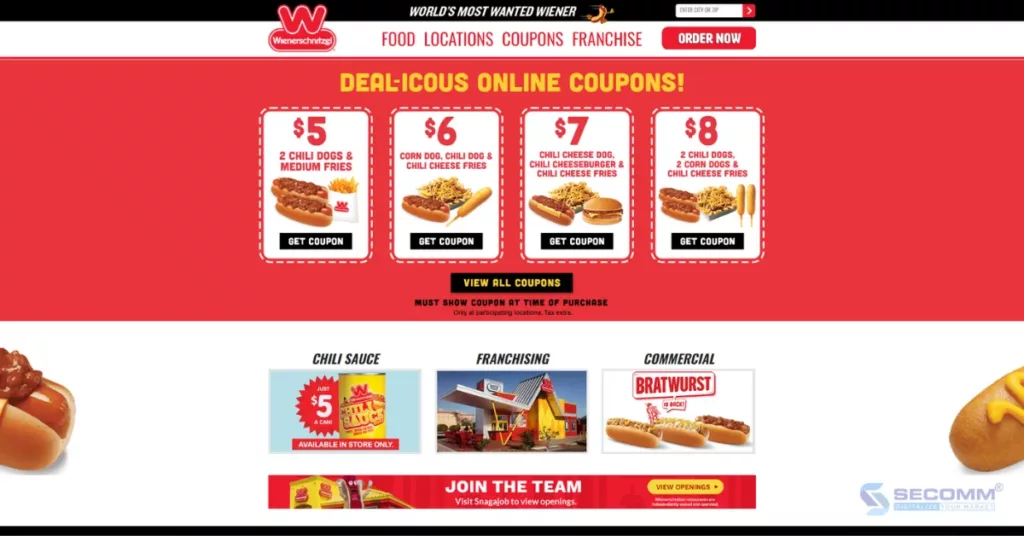
This system also connects franchisees with the main management system, allowing customers to easily locate the nearest restaurants through Google Maps API.
Superdrug Health Clinics is the second-largest well-known health clinic in the UK, with a presence throughout the United Kingdom. The clinics at Superdrug offer various eCommerce pharmaceutical services such as vaccinations for children, sexual health screenings, flu vaccinations, and occupational health services.

By building a basic eCommerce website using WooCommerce, customers can schedule free consultations with nurses/pharmacists or book appointments at specific locations.
GoComics is a popular online comic and cartoon business in the United States. Some iconic cartoons associated with GoComics include Calvin and Hobbes, Garfield, Peanuts, and The Far Side, alongside recent successes like Pearls Before Swine, The Boondocks, and Foxtrot.

By building a WooCommerce website, users can choose between two membership options – free and premium – to gain personalized access to the GoComics library and shop online for items such as art prints, books, and calendars, ideal for comic enthusiasts of all ages.
The Kind Pen is a vape (electronic cigarette) manufacturing company based in Ocean City, New Jersey, USA. With a lifetime warranty and over 1,000,000 satisfied customers, this brand has quickly become a trusted name in the industry.

Kind Pen has decided to use WooCommerce to enhance the user experience on its online store. Images are optimized and converted into fast-loading formats without compromising quality, CSS and JavaScript files are compressed and merged, and with WordPress and WooCommerce extensions, the results have yielded unexpected benefits for user experience, such as a more than 35% increase in website loading speed.
Badeloft is an online retailer of bathroom fixtures founded by Cedric Christiani in Berlin, Germany, in 2009. After achieving certain successes in their home country, Cedric set his sights on the U.S. market. He recruited some high school friends, Eric Jensen and Tyler Kuhlman, and together, they established Badeloft USA at the end of 2013. Today, the company has rapidly expanded to the point where its sales have surpassed the European market.
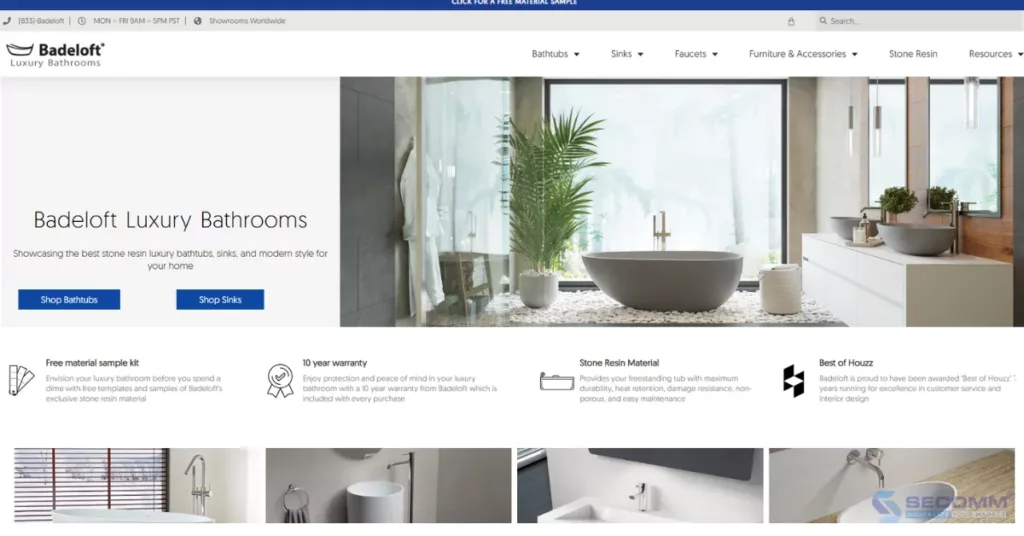
In 2017, Badeloft decided to transition its eCommerce website platform from X-Cart to WooCommerce due to its customization capabilities and the availability of numerous extensions.
All Blacks is the national rugby team of New Zealand and is the most successful international sports team in the past 100 years. With such a long and illustrious history, it’s no surprise that the team’s jerseys, training gear, and support equipment are highly favoured by fans worldwide.

This provided the foundation for All Blacks to establish an online store for the brand on WooCommerce, offering a variety of products for supporters of all ages.
“We selected WooCommerce as it allowed for easy integration into the team’s other back-office systems.“– Norm McKenzie, Meta Digital
Telldus is a Swedish brand specializing in home automation products, aiming to provide simple solutions to everyday problems to enhance one’s quality of life tremendously.

“We believe that simple solutions to small everyday problems can increase one’s quality of life tremendously.”
To expand its customer base in Sweden, Tellus chose WooCommerce to build its website due to its customization capabilities and support for integration with enterprise resource planning (ERP) systems and product information management (PIM).
Grace Loves Lace is a wedding fashion brand founded by Megan Ziems in 2011 in Australia. The brand is renowned for its beautiful, handcrafted, and custom-fitted wedding attire.

After years of development in both offline and online markets, Grace Loves Lace has become one of the most popular and successful eCommerce websites for wedding fashion nationwide. The success is, in part, attributed to the WooCommerce website system designed to focus on professional product images and optimized for high conversion rates and mobile-friendliness.
Daelmans Stroopwafels is the world’s leading company in Stroopwafels (traditional Dutch syrup waffles). Established in 1909, Daelmans has elevated the stroopwafel to become a globally popular pastry.

Over the years, the small bakery in Vlijmen has evolved into an international business. Therefore, building a WooCommerce website is essential, allowing customers to shop online and design their custom stroopwafel boxes.
Established in 1991, Hải Triều has over 30 years of experience in the watch market. To become the leading watch retailer in Vietnam, Hải Triều has combined its eCommerce strategy on the WooCommerce platform with a unique business model to adapt to changes in the market and consumer preferences.

As of now, Hai Trieu’s eCommerce website has over 2 million monthly visits and is a prominent figure consistently topping the rankings in the fashion eCommerce sector in Vietnam (according to iPrice).
Dien Thoai Vui – The name carries a commitment to bring joy and happiness to customers with damaged phones or other electronic devices such as laptops, tablets, smartwatches, etc.

After many years of operation, Dien Thoai Vui has become a familiar destination for many customers both online and offline. The website system of Dien Thoai Vui is built on WooCommerce, allowing customization to a certain extent for the consumer electronics industry’s functionalities, as well as supporting integration with many third-party services.
Clickbuy is a well-known retail system for technology products in Vietnam, established in 2012. Currently, the Clickbuy system has expanded to include 5 stores and 2 modern service centres in Hanoi and Ho Chi Minh City.
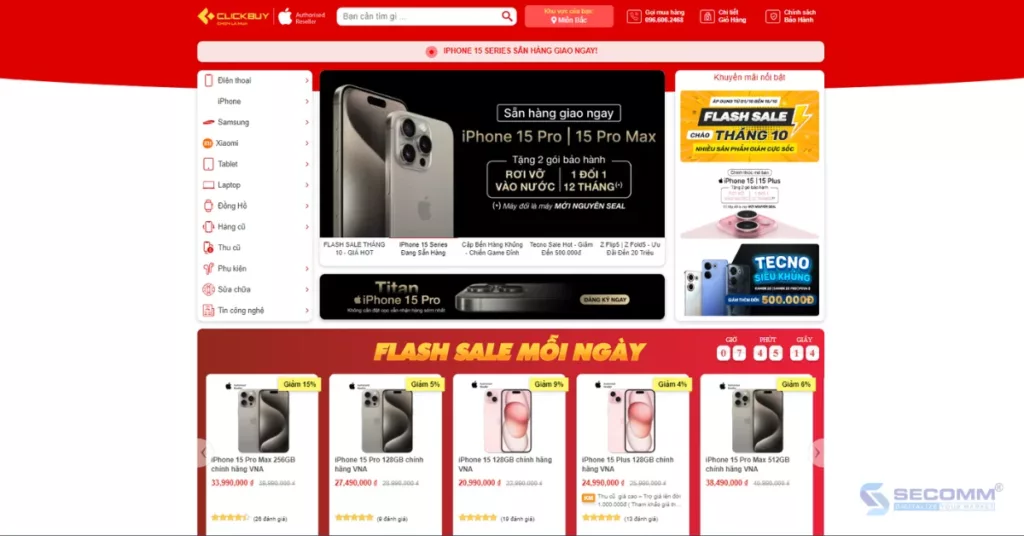
Similar to Dien Thoai Vui, Clickbuy is also built on WooCommerce due to its customization capabilities and integration with many third-party services through WordPress.
Nha Thuoc Than Thien is a retail pharmacy chain meeting GPP standards in Vietnam. This brand specializes in prescription drugs, over-the-counter medicines, and some other healthcare products.

The business combines an offline pharmacy model with an online pharmacy through its main sales channel, an eCommerce website developed with WooCommerce. The website is designed for easy navigation, featuring basic functionalities that help customers easily search for products, make purchases, and track orders.
Paula’s Choice is a skincare and cosmetics brand founded by Paula Begoun, a leading expert in beauty and skincare. This brand is renowned for producing high-quality and meticulously researched skincare products, often recognized for their simplicity and transparency in ingredient disclosure.

After establishing a presence in the Vietnamese market, Paula’s Choice decided to build a website on the WooCommerce platform for the ability to customize the website and leverage the existing functional system.
Beauty enthusiasts in Ho Chi Minh City undoubtedly know about Bo Shop, a brand that offers a wide range of quality cosmetics from skincare to makeup at specific and affordable prices, catering to all beauty care needs.

To become the leading cosmetics retail brand in Vietnam, the company swiftly developed an eCommerce website with WooCommerce to align with modern business trends.
AB Beauty World (ABBW) emerged amid the Covid-19 pandemic in 2020, positioning itself as the leading family cosmetics hypermarket in Vietnam. Despite the seemingly untimely launch, the brand did not succumb to adversity.
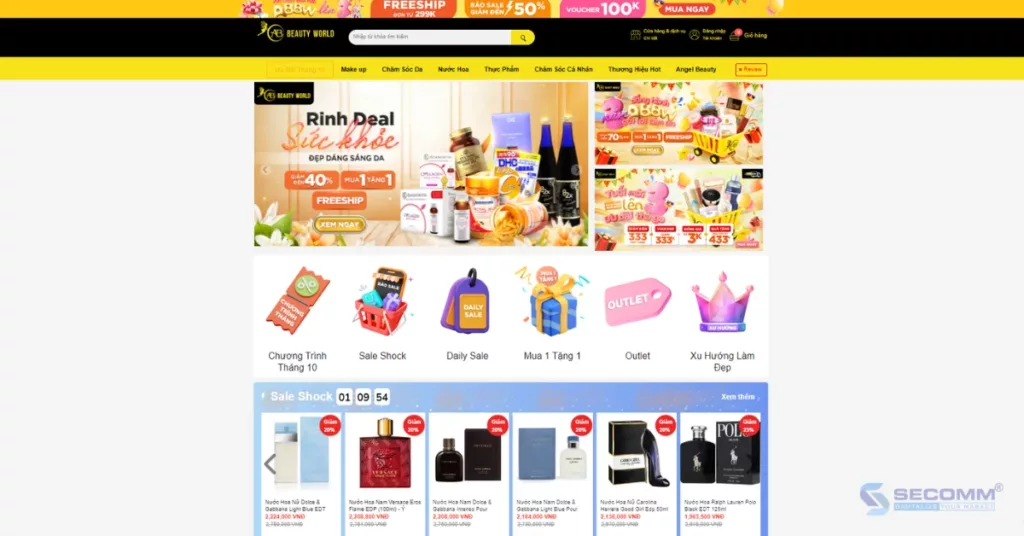
Just two years after opening its first store, AB Beauty World has grown and expanded to nearly 20 branches across districts and neighbourhoods in Ho Chi Minh City, thanks to timely adaptation and a focus on eCommerce development.
The cosmetics selling website of AB Beauty World is built with WooCommerce, featuring industry-specific design and functionality. In a short time since its launch, the website has garnered high traffic for a newcomer in the digital transformation race.
Founded in 2004, Orchard is the destination for over 200 premium perfume brands worldwide. To become the number one perfume retail brand in Vietnam, Orchard early on implemented eCommerce to tap into the ‘gold mine’ of this market.

To date, Orchard’s eCommerce website, built with WooCommerce, is the top choice for customers who love to shop for perfumes online.
With a minimalist and cosy interior design style, Nhà Xinh (Beautiful Home) chooses simplicity for each of its products. This is evident in the eCommerce website’s interface, which is built on the WooCommerce platform, and features a simple and user-friendly design.
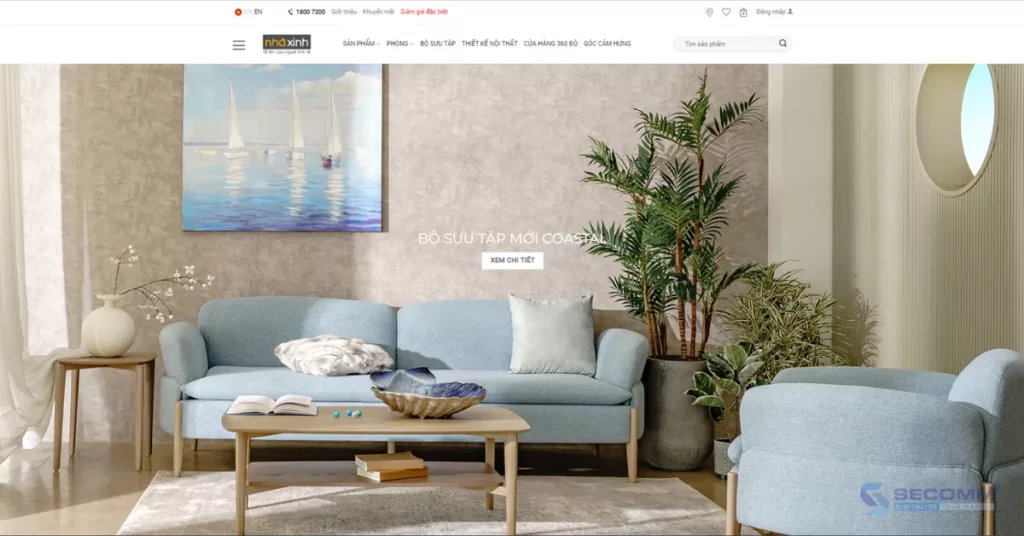
In addition, Nha Xinh’s website incorporates 360-degree technology, allowing customers to experience the company’s furniture products remotely in a realistic manner, exploring every nook and cranny of the room and every angle of the product with detailed information and pricing for each item.
Established in 2007, Vietnam Wine Cellar Co., Ltd. is one of the largest wine companies in Vietnam, specializing in providing a wide range of products, including wine, beer, whiskey, food, mineral water, tea, and high-quality ceramics.

Winecellar pursues an eCommerce business model by investing in building a website on the WooCommerce platform. Through this, the company can easily reach numerous potential customers in the online market.
Above is a list of the top 20 eCommerce websites using the WooCommerce platform in both the international and Vietnamese markets.
With deep expertise and experience in developing complex eCommerce systems on WooCommerce for various clients such as Laybyland (Australia, the US, New Zealand), Jasnor (Australia, New Zealand), and The Warehouse (Vietnam), SECOMM understands the challenges in choosing a platform and implementing eCommerce solutions that businesses are currently facing.
Contact SECOMM today or call directly on the hotline (028 7108 9908) for a free consultation on deploying a WooCommerce website for your brand.
 2
2
 8,159
8,159
 0
0
 1
1
According to Adobe’s report in January 2023, there are more than 100,000 websites built using Adobe Commerce. Among them, over 50,000 websites are actively running, and more than 50,000 websites are in the deployment phase. This is an extremely impressive number for a platform specialized in supporting large enterprises like Adobe Commerce.
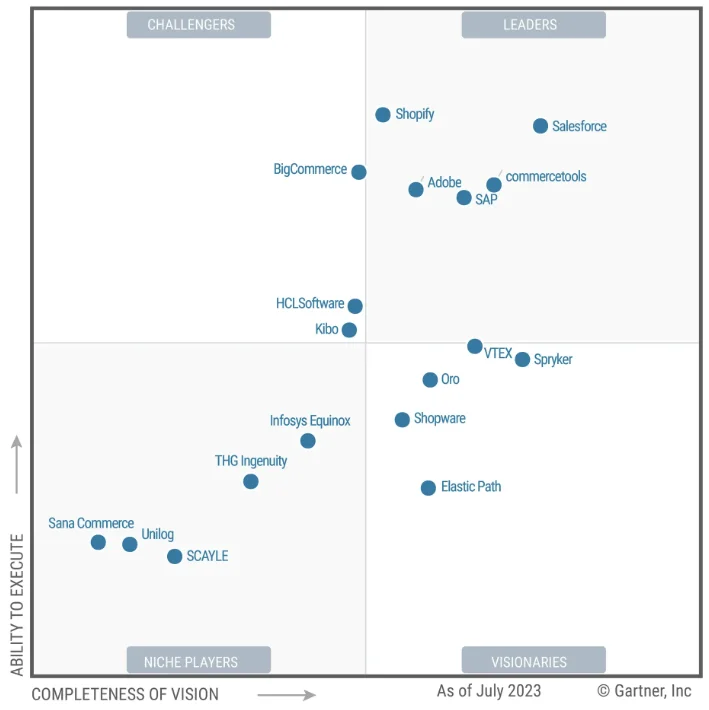
In 2023, Adobe Commerce was recognized by Gartner for its outstanding achievement, ranking first in the list of leading platforms in digital commerce for seven consecutive years.
Adobe Commerce is an open-source eCommerce platform designed specifically for businesses ranging from medium to very large scale, offering high customization and scalability.

Formerly known as Magento Commerce, it was founded in 2007 by Roy Rubin and Yoav Kutner in Culver City, California, USA. After several changes of ownership, in 2018, Adobe acquired Magento for $1.68 billion and rebranded it as Adobe Commerce. Currently, Adobe Commerce is part of the Adobe Experience Cloud, a product and service suite helping businesses create, manage, and distribute digital experiences.
Adobe Commerce has two main versions: Adobe Commerce Cloud and Magento Open Source.
Adobe Commerce Cloud is a paid version, deployed and managed on the cloud by Adobe. It is divided into two types: on-premise, allowing businesses to be self-sufficient in hosting, and on-cloud, providing hosting at a specific cost.
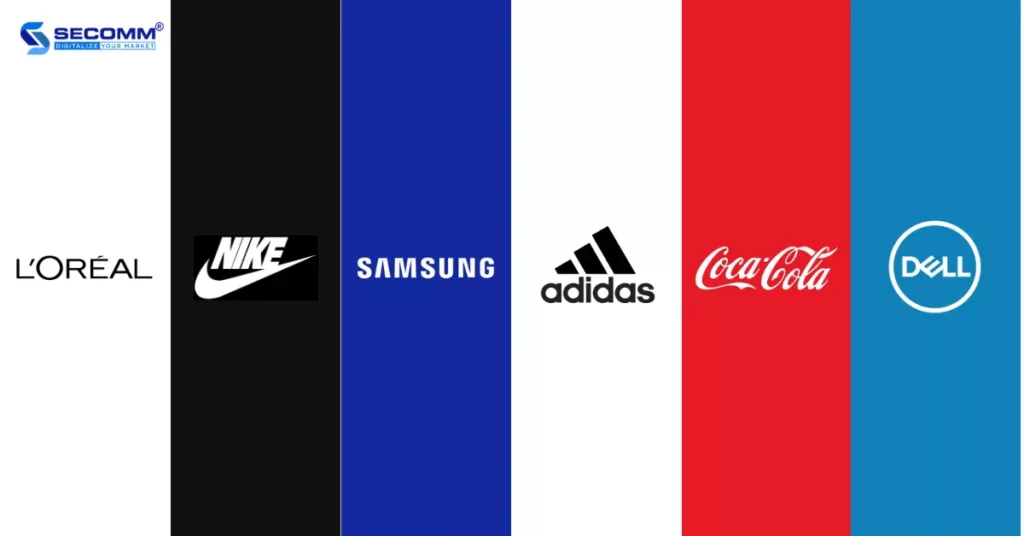
Magento Open Source is a free version that can be downloaded and used by anyone. It provides essential functionalities for creating and managing online stores.

In addition, Adobe offers several additional versions of Adobe Commerce:
The cost of using Adobe Commerce depends on the version being used.

For Adobe Commerce Cloud (On-Cloud): Adobe provides hosting and operates Adobe Commerce on its cloud. License costs for Adobe Commerce on-cloud range from $40,000 to $190,000 per year, depending on the system’s complexity, scale, and business requirements.
For Adobe Commerce Cloud (On-Premise): Businesses need to purchase licenses and install the software on their servers. License costs for Adobe Commerce on-premise range from $22,000 to $125,000 per year, depending on system complexity, scale, and business needs.
For Magento Open Source: Magento provides a free license, and the overall cost is generally more reasonable compared to the two solutions above. However, the available built-in functionalities are limited, and additional investments are required for feature development and integration with third-party services.
In addition to license costs, businesses also need to invest in interface design, development costs, extension utility costs, and employee salaries.
Note: The cost of using Adobe Commerce can be significantly influenced by factors such as business scale, feature requirements, integration needs, and customization requirements.
Read more: Shopify Plus vs Adobe Commerce: Key differences 2023

Adobe Commerce is a powerful eCommerce platform, providing all the essential features for building and managing a comprehensive eCommerce website. From product portfolio management, content creation, and conducting transactions, to marketing campaigns and customer management, Adobe Commerce is equipped with all the necessary tools.
In addition to basic features, Adobe Commerce offers many extensions with advanced functionalities.
One of the significant strengths of Adobe Commerce is its globally experienced support community, consisting of professional developers who assist in finding and solving any technical challenges or customizations needed for businesses. This creates favourable conditions to meet every requirement and goal of the business’s eCommerce.
Adobe Commerce possesses all the advantages of an open-source platform with flexible customization capabilities. Especially with ownership and control over the entire source code, businesses can easily customize code sections within the system, easily update, or even develop new features based on specific business needs.
In addition to customization capabilities, Adobe Commerce has excellent scalability for websites. Adobe Commerce allows businesses to expand from one website to multiple websites, one store to multiple stores while still managing everything on the same system. Additionally, Adobe Commerce supports multilingual and multi-currency conversions, helping businesses expand globally.
High-security capability is also a standout advantage of Adobe Commerce with regular system monitoring, proposed security solutions, enhanced security for administrators, and the ability to prevent bots or unauthorized malicious code. This platform helps businesses minimize potential risks from data systems and transaction processes on the system
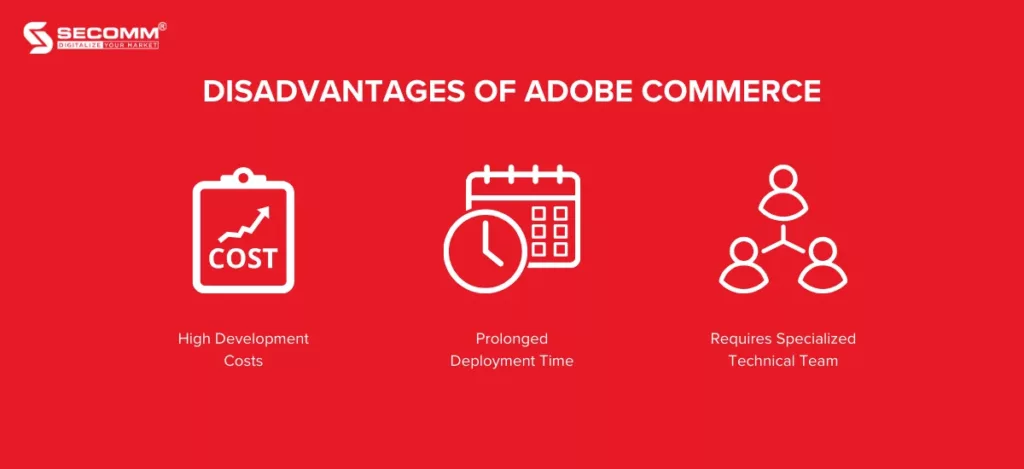
Due to its numerous outstanding features in functionality, customization capabilities, scalability, and high security, the cost of owning an Adobe Commerce website is inevitably high. As estimated earlier, websites developed on the Adobe Commerce platform often have higher costs compared to other platforms, ranging from $10,000 to $300,000 depending on the system’s complexity.
A complete Adobe Commerce project requires a deployment time ranging from 3 months to 1 year. This extended duration slows down the digital transformation process of businesses, making it challenging for them to keep up with the pace of development among competitors and stay updated with market trends.
To build and operate an in-depth eCommerce website system tailored to the specific characteristics of each product and industry with high performance, businesses require a specialized technical team with in-depth expertise. This is particularly crucial for complex Adobe Commerce projects, demanding a high level of technical specialization and experience on the Adobe Commerce platform.
As one of the world’s most renowned sportswear brands, Nike aimed to adopt a personalized eCommerce approach with a focus on mobile device experience. Hence, Nike chose Adobe Commerce to enhance its functionality, concentrating on user experience, increasing interaction, and optimizing images and CTA buttons for smaller screens.

Additionally, customizing and optimizing the eCommerce website-building method through the Headless Commerce API architecture contributed to Nike’s success, turning the brand into a market leader and gaining more market share than its competing counterparts.
Canon, a multinational corporation based in Japan specializing in manufacturing cameras, printers, optical equipment, digital imaging devices, and office equipment, needed to build an eCommerce website to meet digital transformation needs after a long period of traditional business. Canon decided to select Adobe Commerce to deploy a comprehensive eCommerce solution.

“The Commerce and Experience Manager tech stack helps us compress projects that previously took months of development time into just weeks. We can do so much more than before — if we’re developing a new component and trying to get it out within a couple of weeks, we can do that now” — Michael Lebron, Senior Director and Head of Front Office Applications
Annam Gourmet is a premium food and beverage retail brand in Vietnam established in 2001 by a French-Vietnamese couple. Although Annam Gourmet had an online presence before, it was mainly used to develop the brand, and the effectiveness of eCommerce was not emphasized. Annam Group, the parent company of Annam Gourmet, along with partner SECOMM, chose to use Magento 2 to build an eCommerce website.
Currently, Annam Gourmet’s Magento 2 website has officially launched, operating stably and effectively, helping the business successfully transform in the eCommerce market. Besides the Annam Gourmet project, Magento is also chosen by the Annam Group for other retail eCommerce systems within the group, such as The Warehouse (wine retail) and Nespresso.

In general, Adobe Commerce is a suitable eCommerce platform for businesses of all sizes, from startups and SMEs to large corporations. However, issues related to budget, time, and specialized teams have made many small and medium-sized enterprises hesitate to use Adobe Commerce for deploying eCommerce websites. Therefore, Adobe Commerce is often invested in by large enterprises to build in-depth eCommerce systems.
With profound experience and the development of numerous complex eCommerce systems on Adobe Commerce, such as Laybyland (Australia, the US, New Zealand), Jasnor (Australia, New Zealand), and The Warehouse (Vietnam), SECOMM understands the challenges in the platform selection and eCommerce deployment that businesses are facing.
Contact SECOMM today or call directly at the hotline (028 7108 9908) for a free consultation on deploying Adobe Commerce for your brand.
 2
2
 9,085
9,085
 0
0
 2
2
According to Grand View Research, the global jewelry eCommerce market is predicted to reach USD 117.8 billion by 2027, with a CAGR of 12.2% from 2022 to 2027. According to Research and Markets, the United States is the largest jewelry eCommerce market in the world, with expected revenue of USD 45.6 billion by 2027. Other regions, including China, India, and Southeast Asia, are also experiencing rapid growth.
Several jewelry brands have successfully implemented eCommerce early on and achieved unexpected success, such as Cartier, Tiffany & Co., PNJ, ANA LUISA, Missoma, etc. The common characteristic of these brands lies in comprehensive eCommerce websites that cater to customers’ needs for purchasing jewelry and gemstones.
For more information:
With nearly 10 years of experience in eCommerce, SECOMM has outlined the common journey of building jewelry eCommerce websites in Vietnamese businesses.

Firstly, businesses in the jewelry industry need to clearly define their goals and prioritize each of these goals when planning the development of an eCommerce website.
In the long-term vision, businesses may be interested in building and strengthening their brand presence in the online market, exploring the potential of online customers, and optimizing business operations from online to offline.
For short-term objectives, businesses may prioritize monitoring and analyzing customer behaviour on the website, assessing the effectiveness of online marketing campaigns to improve sales performance.
When setting objectives, the timeframe is also a crucial factor. Businesses may choose to deploy quickly to penetrate the eCommerce market or even opt for a gradual deployment to have time for testing, evaluation, and adaptation to this large and competitive market.
Currently, two popular types of platforms support the development of eCommerce websites: SaaS (Software as a Service) and open source.

Read more:
Typically, new businesses entering the eCommerce market will choose SaaS platforms to save time and costs during the initial stage of building an eCommerce website. Subsequently, businesses may transition to open-source platforms for the development of more advanced eCommerce websites.
However, businesses can also choose an open-source platform right from the start to build a basic eCommerce website and later upgrade the system over time on the same platform to avoid the need for platform migration in later stages.
When designing the website interface, businesses need to meet basic criteria such as UI/UX standards, reflecting the brand’s characteristics, presenting products consistently, providing complete usage instructions, etc.

Currently, there are three ways to design the interface, including:
In this stage, businesses often choose ready-made themes to save costs, but some financially stronger businesses may opt for the other two methods to better position their brand.
In this stage, businesses can prioritize the development of basic functions to meet the most fundamental needs when operating a jewelry eCommerce website. Some essential functions that should be included in a jewelry eCommerce website are:
After successfully completing the features, testing, and launching of the website, the business needs to fulfil legal procedures related to eCommerce operations. According to Decree 52/2013/ND-CP issued by the Government of Vietnam, individuals or organizations owning eCommerce websites for sales are required to notify or register with the Ministry of Industry and Trade through the Public Service Portal of the Ministry of Industry and Trade.
Note: Websites that operate for an extended period or fail to register/notify the competent management authority within the specified time frame may be subject to administrative penalties as stipulated by the regulations.

When a business is in the development phase and the market is undergoing significant changes, adjusting objectives becomes necessary. This is particularly crucial when leadership needs to review the business strategy and make decisions regarding investing in an eCommerce website, including both time and budget considerations.
In this phase, businesses often focus on setting short-term and long-term goals for the online jewelry business system. For long-term objectives, businesses may consider expanding the brand presence in the market, building a loyal customer program, and promoting the purchasing habits of jewelry and gemstone customers in the middle and upper classes. These goals lay the foundation for sustainable development and prosperity in the future.
Regarding short-term goals, businesses may concentrate on attracting additional potential customers, increasing revenue, and supporting the eCommerce marketing strategy. Tools such as Influencer Marketing may be prioritized to drive rapid growth and create immediate business opportunities.
Overall, establishing specific goals and adjusting them based on market conditions and business development is a crucial part of managing and succeeding in the eCommerce jewelry industry.
When basic SaaS platforms are no longer sufficient to support the expansion of the website system, businesses will need to transition to more specialized platforms such as Adobe Commerce, Shopify Plus, BigCommerce Enterprise to develop a more advanced eCommerce jewelry website.

Read more:
Of course, when switching platforms, businesses will face challenges such as conversion costs, time required for staff training on the new platform, and potential data loss during the platform migration.
To build a professional and complex eCommerce website, businesses need to choose suitable resources to implement the project. Generally, there are two main options: building an in-house team or partnering with a professional development partner. Regardless of the choice, specialized knowledge and experience in the chosen field are crucial.
When deciding to build an in-house team, businesses need to recruit and train IT and eCommerce personnel with knowledge and practical experience on the chosen platform. This may require a significant amount of time and financial resources to build a suitable workforce. However, this approach allows the business to have better control over resources and the ability to make adjustments, developing the website system according to specific requirements.
Another option is to collaborate with a professional development partner. In this case, businesses should seek a partner with extensive experience in eCommerce, a professional team, clear work processes, and the ability to handle complex projects. Collaborating with specialized units helps businesses learn and accumulate more experience while developing an eCommerce website that suits the specific characteristics of the jewelry industry.
Therefore, the choice between building an in-house resource and collaborating with a development partner depends on the goals, resources, and specific requirements of the business.
During the platform transition process, businesses may decide to keep the current website interface if the brand believes it still aligns with the strategy and the new platform. However, many businesses often choose to redesign the interface to ensure that the eCommerce website reflects the brand’s business strategy and the new platform accurately.

Similar to the previous stage, businesses have several options when designing the eCommerce website interface: using ready-made themes available on the market, customizing themes, and designing a unique interface.
In the jewelry industry, customizing or designing a unique interface is often prioritized to showcase the uniqueness and sophistication of the products. However, the final decision should be based on the business strategy and resources available.
After choosing a suitable conversion platform, the redesign of the system and platform conversion is crucial. This requires a high level of expertise from solution architects to design a system that can address the challenges the business is facing and align with the long-term development journey and business model of the enterprise.
In addition, the process of migrating data also needs to be carried out carefully to limit the risk of data loss or errors for the business. Typically, data conversion is automated as much as possible to avoid potential errors.
The platform conversion process includes the following steps:

In addition to basic functions, at this stage, businesses should focus on building more sophisticated system functions, including advanced and industry-specific features for the jewelry sector.

Furthermore, businesses need to continuously innovate and update to develop user-friendly functions and keep up with market trends.
Operating an eCommerce system is an ongoing process that businesses must carry out to ensure the system operates smoothly and efficiently. This process includes the following crucial tasks:

Additionally, continuous care, maintenance, updates, and upgrades of the website system are essential for businesses to sustain sustainable growth and adapt quickly to changes in the eCommerce market, especially in the jewelry and gemstone product sector.
After a period of operation, businesses should shift their focus to eCommerce marketing strategies or omnichannel strategies to boost the sales of jewelry products.
Implementing omnichannel involves setting up a seamless sales, marketing, and management system through various channels such as the website, social media platforms (Facebook, Instagram, Zalo, TikTok Shop), and eCommerce platforms (Shopee, Tiki, Lazada, Sendo) to optimize the customer experience and enhance business efficiency.
Developing a comprehensive marketing strategy and plan based on key eCommerce marketing channels such as Content Marketing, SEO/SEM, Email Marketing, and Affiliate Marketing is essential for rapid business growth.
In conclusion, the journey of building an eCommerce website for the jewelry market in Vietnam is not an easy one. This journey requires businesses to invest a significant amount of time and budget to research the most suitable eCommerce strategy for each stage of their development.
Understanding the difficulties and challenges that businesses face when building an eCommerce jewelry website, SECOMM is ready to provide free consultations and detailed solutions for the development of an eCommerce system tailored to the specific needs of each business.
Contact SECOMM today or call directly at the hotline (028 7108 9908) for a free and detailed consultation.
 2
2
 8,588
8,588
 0
0
 1
1
eCommerce is increasingly thriving and becoming a popular sales channel, especially in the jewelry industry, with global eCommerce jewelry sales reaching $100 billion in 2022 and projected to reach $150 billion in 2025.
To harness the immense potential of this market, choosing the right eCommerce platform is a crucial part of the success of your jewelry business in this billion-dollar market
Read more: What opportunities are open to jewelry eCommerce?
A professional interface is one of the crucial criteria to consider when building an eCommerce website for jewelry. This criterion helps businesses create a positive impression on customers, increase conversion rates, and boost sales.

Here are some factors to note when designing the website interface:
When building a jewelry website, in addition to basic eCommerce functions, businesses need to focus on developing advanced features that address industry-specific needs:
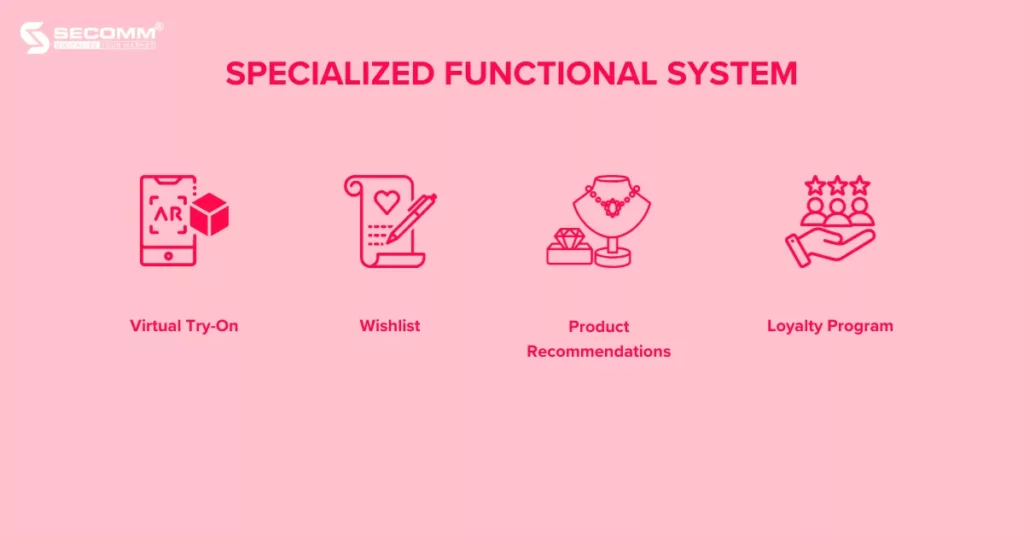
An eCommerce jewelry website needs to have high scalability to meet the evolving needs of the business in the future. Here are some factors to consider when evaluating scalability:
Jewelry is a high-value item, so an eCommerce jewelry website needs to have high security to ensure the safety of customer information and prevent fraudulent activities and theft online.
As eCommerce jewelry websites often require customers to provide personal information such as name, address, phone number, email, credit card details, bank account numbers, etc., for ordering and payment purposes, ensuring the security of this information is crucial. If this information is compromised, customers may fall victim to scams, lose money, or have their privacy violated.
Shopify is a SaaS eCommerce platform founded in 2006. Over the years, Shopify has rapidly become a leading platform in the eCommerce industry, supporting numerous businesses worldwide in establishing and growing their online presence.

The costs associated with using the Shopify platform vary and include:
Read more: Top 5 benefits when applying Headless Commerce in 2023
Evaluating the suitability of Shopify for the jewelry industry:
Several jewelry businesses currently utilizing Shopify for their eCommerce websites include Made by Mary, MISSOMA, Pura Vida Bracelets, and J&CO.
Shopaccino is a SaaS platform established in 2014 in India, specializing in assisting both B2C and B2B businesses in building eCommerce websites across various industries, including the jewelry sector.

Shopaccino currently offers three main solutions:
Evaluating the suitability of Shopaccino for the jewelry industry:
Some jewelry businesses currently using Shopaccino include Navratan, KOSH, Bibelot Jewels, Greytone, Hiranya Store, Lavie Jewelz, and Euro Gems S.R.L.
Shift4Shop is an eCommerce platform developed by Shift4 Payments, a technology payment company. Shift4Shop provides a comprehensive eCommerce solution for businesses of all sizes and industries, including jewelry businesses.

Currently, Shift4Shop only offers services in the U.S. market with four solutions ranging from free to fee-based:
Evaluating the suitability of Shift4Shop for the jewelry industry:
Some brands currently using Shift4Shop include Jewelry Supply, Too Cute Beads, Sasha’s Gemstone Jewelry, Alara Jewelry, Diamond Jewelry NY, and Just Mens Rings.
WooCommerce is an open-source eCommerce plugin developed for the WordPress platform, one of the most popular content management systems (CMS) worldwide. WooCommerce allows businesses to turn their WordPress websites into online stores or integrate eCommerce features into existing websites.3

The cost of using WooCommerce depends on the complexity of each project, averaging $1,000 for a basic eCommerce website and $10,000 for a deeply customized eCommerce website.
Evaluating the suitability of WooCommerce for the jewelry industry:
Some businesses using WooCommerce to build jewelry websites include April Soderstrom, NEWTWIST, Waufen, Hyo Silver, Alkemistry, Oxétte, Arden Jewelers, and Binenbaum Antiques & Jewelry.
Adobe Commerce, formerly known as Magento Commerce, is a professional and popular eCommerce system. Adobe Commerce is part of the Adobe Experience Cloud product line and is designed to help businesses build eCommerce websites.

Currently, Adobe Commerce offers two main versions:
Read more: Magento Open Source vs Magento Commerce Real Comparison
Evaluating the suitability of Adobe Commerce for the jewelry industry:
Some businesses using Adobe Commerce to build jewelry websites include True Facet, Hannoush, Judaica, Mikimoto, Charles and Colvard, J.R.DUNN, and EraGem.
Above are some eCommerce platforms suitable for the jewelry eCommerce industry. This list is just a few examples for businesses to consider, as there are many other eCommerce platforms that businesses can explore based on specific needs and available resources.
Understanding the challenges and difficulties that businesses may face when building a jewelry eCommerce website, SECOMM is ready to provide free consultations on detailed eCommerce system development solutions for businesses.
Contact SECOMM today or call directly at the hotline number (028 7108 9908) for free and detailed advice.
 2
2
 9,230
9,230
 0
0
 1
1
The jewelry eCommerce sector is a promising market experiencing swift growth. According to statistics, the global eCommerce jewelry market is currently valued at about 57.4 billion USD and is anticipated to reach approximately 117 billion USD by 2027.

Jewelry eCommerce involves selling various jewelry items, including necklaces, rings, earrings, bracelets, gold, silver, diamonds, pearls, gemstones, and other pieces, conducted through online channels.
This type of eCommerce involves the purchase and sale of jewelry products through websites, applications, or online marketplaces.

Jewelry eCommerce is increasingly thriving, especially in the context of the COVID-19 pandemic. According to a report from the Vietnam eCommerce Association (VECOM), the Vietnamese jewelry eCommerce market is estimated to reach 10 trillion VND in 2022, showing a growth of 25% compared to 2021.
Several factors are driving the potential of jewelry eCommerce, including:

According to the World Bank report, the middle class in Vietnam is steadily increasing, from 13% of the population in 2016 to 26% in 2026. It is expected that the middle class in Vietnam will continue to grow in the coming years.
On a global scale, according to the McKinsey Global Institute report, the global middle class is projected to increase from 1.8 billion people in 2020 to 4.9 billion people in 2030. This growth will generate significant demand for premium products and services, including jewelry and gemstones.
According to Metric report, as of June 2023, Vietnam has over 100,000 eCommerce websites, a 20% increase compared to 2022. The most popular product categories on Vietnam’s online marketplaces include fashion, home appliances, electronics, and jewelry.
On the international market, according to Statista’s report, as of June 2023, there are over 280 million active eCommerce websites worldwide.
The growth of online shopping channels, specifically individual eCommerce websites, has created many opportunities for jewelry eCommerce businesses to reach a larger audience, including customers in distant regions away from the main stores.
The advancement of technology is one of the crucial factors driving the potential of jewelry eCommerce. When integrating innovative technologies like VR/AR, and AI into your jewelry website will enrich the online shopping experience, making it more engaging and appealing to customers.
Alongside the opportunities, jewelry brands still have to confront the challenges of the market

The jewelry industry faces intense competition, with numerous businesses, both large and small, vying for market share. This requires jewelry brands to exert efforts to compete in terms of pricing, product quality, and the services they provide on their eCommerce website.
Counterfeit goods are often made from low-quality materials and are significantly cheaper than genuine products. This poses a significant challenge for the online jewelry market, as consumers struggle to differentiate between authentic and fake items, leading to adverse effects on jewelry brands.
Market trends are always changing, particularly in the jewelry eCommerce industry. It requires you to stay constantly updated to cater to evolving customer demands.
When purchasing jewelry products, customers desire an online shopping experience similar to in-store shopping. Because they want to view products directly, read reviews from other customers, and receive guidance from sales staff.
Tiffany & Co. is a premium jewelry brand headquartered in New York, USA, established in 1837 by master jeweler Charles Lewis Tiffany. The company embraced eCommerce early on and has become one of the largest online jewelry retailers globally.

Tiffany & Co.’s eCommerce website is built on the Adobe Enterprise Cloud platform, enabling the business to provide flexibility and scalability to meet customization needs and long-term development goals.
Leveraging resources from the leading Adobe Commerce eCommerce platform, the business has utilized Adobe Experience Platform Launch, Adobe Target, Adobe Experience Platform Identity Service, and more to deliver customized and personalized services for its customers.
Pandora is a retail jewelry brand established in 1982 by Per Enevoldsen in Copenhagen, Denmark. The brand is known for customizable bracelets and other specially designed jewelry lines.

Pandora’s eCommerce website for the US and UK markets is built on the Salesforce Commerce Cloud platform, while the Vietnamese market utilizes Haravan. Therefore, the US and UK versions will have more specialized features such as wishlists, quick view, product comparison, loyalty programs, etc.
PNJ, or Phu Nhuan Jewelry, is a reputable jewelry brand with a long history and a widespread network of stores across Vietnam. Founded in 1988 in Phu Nhuan District, Ho Chi Minh City, Vietnam.

Initially, PNJ’s eCommerce website was built on the CS-Cart platform. As it grew, PNJ re-platform to WooCommerce to design its eCommerce website. This move benefits the PNJ website with many amazing features, including diverse payment method integration, product size customization, store location search based on province/city and district, and the flexibility of choosing between home delivery and in-store pickup.
The Bottom Line
In general, jewelry brands face numerous challenges and opportunities to make strides in the eCommerce landscape. Achieving success in this industry requires innovation, responsiveness to customer demands, and staying abreast of the latest technological trends.
Learn more: 10 Jewelry eCommerce Websites in Vietnam & Worldwide
Understanding both the opportunities and challenges when deploying jewelry eCommerce websites, SECOMM has a team of experts and a wide range of solutions to help you make it a reality.
Contact us or call the hotline at 028 7108 9908 to get started!
 2
2
 10,133
10,133
 0
0
 2
2
Jewelry eCommerce is a significant playground for many players. Exquisite jewelry pieces made from gemstones, gold, and silver are brought closer to consumers through eCommerce websites.
Brands worldwide, including those in Vietnam, not only strive to introduce a series of creatively innovative collections but also emphasize providing a better online shopping experience for customers.
Learn more: What opportunities are open to the jewelry eCommerce?
Let’s explore the allure of the jewelry world through the list of the 10 most notable jewelry eCommerce websites in Vietnam and around the world.
With a history spanning over a century, Cartier has firmly established itself as a symbol of luxury and sophistication in the jewelry market.
Renowned for its exquisite and unique jewelry creations made from the finest gemstones and precious metals, including gold and silver, Cartier goes beyond merely producing and selling products.
The brand also offers services such as care, repairs, and gift packaging.

Cartier’s eCommerce website is meticulously crafted on the Salesforce Commerce Cloud, a leading open-source platform for eCommerce development. This choice ensures that the online shopping experience on Cartier’s platform is optimized to reflect the brand’s spirit and values.

The website design embraces a minimalist approach and incorporates various features such as AR, allowing customers to examine products from different angles visually. Additionally, it features an intelligent search system that provides accurate results even if customers make typing errors and allows for checking product availability at any store.
Tiffany & Co. stands as a premier and globally renowned jewelry brand. Its product range includes exquisite jewelry items such as rings, necklaces, earrings, and watches, crafted from precious metals like silver, gold, and platinum, along with precious gemstones such as diamonds, pearls, and green beryl.

Tiffany & Co.’s eCommerce website is built on the Adobe Commerce platform. offers flexibility and scalability to meet custom needs and long-term development goals. Similar to Cartier, Tiffany also provides customers with various services, including product selection advice and product care.
Notably, Tiffany’s website includes an outstanding store locator feature based on the radius, enabling customers to easily identify the nearest stores based on city, zip code, and offered services, facilitating a seamless shopping experience.
With over 30 years of reputation in the crafting and selling of high-end jewelry, PNJ is one of the most renowned jewelry and diamond brands in Vietnam.
PNJ offers customers a diverse and extensive selection of jewelry, catering to every need and aesthetic preference, from wedding jewelry, feng shui jewelry, diamond jewelry, colored stone jewelry, and Italian gold jewelry, to Disney and STYLE by PNJ jewelry.

PNJ’s eCommerce website is built using the PHP programming language, a popular and effective language for developing web applications. The website features a user-friendly interface, allowing customers to quickly and conveniently view, search, compare, and purchase jewelry products.
The website also includes several notable features, such as integrated diverse payment methods, product size selection, store search by province/city and district, and options for home delivery or in-store pickup.
Originating from New York, USA, ANA LUISA is a prominent jewelry brand with a vision of enhancing life through unique and luxurious jewelry pieces. ANA LUISA selects premium materials such as 14k gold, 925 sterling silver, lab-grown diamonds, and cultured pearls to create diverse collections suitable for every style and personality.

The eCommerce website of ANA LUISA is built and developed on the Shopify SaaS platform. The website features a simple and elegant design with a white color scheme, fitting seamlessly into the accessory and jewelry industry. ANA LUISA focuses on enhancing features to provide the best online shopping experience for customers.
Features include order tracking by order number and zip code, quick product view, pre-ordering with notifications upon availability, product recommendations based on viewing history, and displaying the number of products sold within the last 24 hours.
Missoma is a jewelry brand hailing from London, UK, specializing in gold and silver recycled jewelry with modern, refined, and distinctive designs. The brand features several standout jewelry collections, including Lucy Williams, Harris Reed, Savi, Zenyu, Molten, and many more.

The eCommerce website design of Missoma reflects the inherent sophistication and minimalism of the jewelry industry. The website is built and developed using Shopify, facilitating easy integration with a variety of third-party applications to enhance the customer shopping experience with richness and quality.
Some notable features of Missoma include the integration of diverse payment methods, including Buy Now Pay Later with Klarna; an automatic multi-currency conversion feature based on the user’s IP; product filtering based on material and size; and the incorporation of the loyalty program “The Rewards Stack” for loyal customers.
Founded by Michael Saiger in 2008, Miansai is a leading American jewelry brand. Miansai specializes in creating simple, elegant, and unique designs for both men’s and women’s jewelry, using carefully selected and handcrafted raw materials. The brand offers various jewelry collections, including necklaces, bracelets, rings, earrings, keychains, and many other accessories.

Miansai also utilizes the Shopify platform to build its eCommerce website, incorporating industry-specific features such as product size selection, product and collection filtering and searching, automatic currency conversion based on the user’s IP, search suggestions, and integration with social media platforms like Facebook, Pinterest, and Instagram.
Catbird is a high-end jewelry brand established in 2004 in New York City, USA. The brand is known for its sophisticated and artistic designs. Catbird’s products are crafted from various materials, including gold, silver, gemstones, and more.
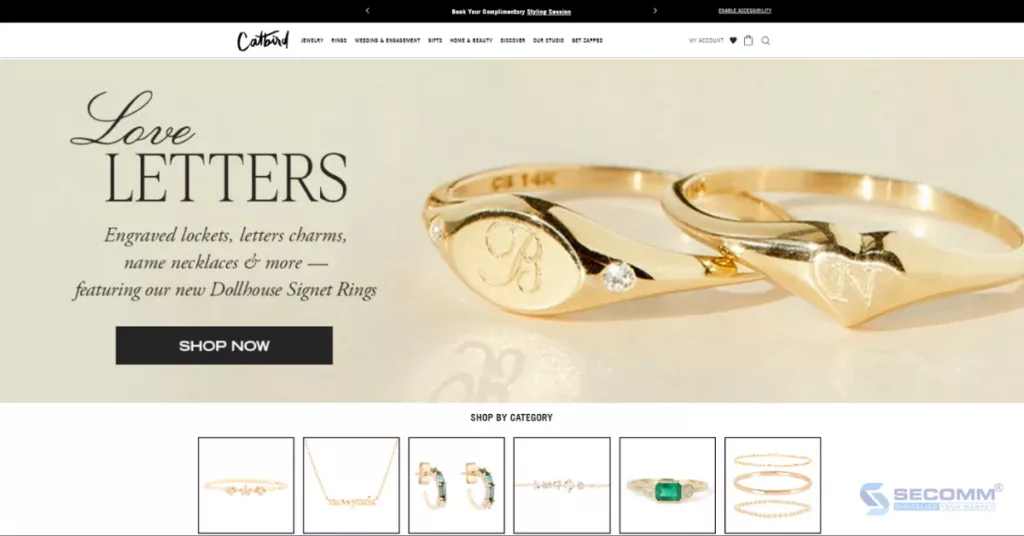
The eCommerce platform of the Catbird jewelry website is Magento Open Source, offering exceptional flexibility that allows the brand to build a range of enhanced features for a smooth and enriching shopping experience for customers.
Some notable features on the Catbird eCommerce website include product search and filtering, product size selection, personalized jewelry customization options, and automatic currency conversion based on the user’s IP.
Notably, the Catbird website includes a “Web Accessibility” feature, allowing customization of website accessibility, including adjusting viewing modes for users, modifying content size and alignment, and changing interface colors.
Huy Thanh Jewelry is one of the renowned jewelry brands in Vietnam. With a mission to bring beauty and value through each piece of jewelry, the brand has made a mark in the hearts of consumers with its exquisite and unique products, handcrafted from precious gemstones and metals such as gold and silver.

The Huy Thanh Jewelry eCommerce website is built on the Haravan Enterprise platform, one of the popular eCommerce platforms in Vietnam. Some notable features of the Huy Thanh Jewelry website include product filtering and search, customization of size, material, and color, as well as integration with various social platforms and payment methods.
EROPI is another prominent jewelry brand in Vietnam specializing in distributing various types of gold, silver, jewelry, gemstones, pearls, wedding jewelry, and feng shui jewelry. After many years of operation, the company has expanded its chain of stores nationwide and developed an online sales channel to meet the shopping needs of customers.

EROPI’s primary online channel is its eCommerce website, which has been invested in and built on the Magento Open Source platform. With excellent customization capabilities, this platform allows EROPI to create advanced features and flexible expansion capabilities, ensuring the long-term development goals of the business.
STONE AND STRAND is a jewelry brand established in 2013 in the United States. STONE AND STRAND offers a range of jewelry products, including rings, necklaces, earrings, and various other jewelry designs. All products are designed with exquisite craftsmanship and perfect details, reflecting the brand’s creative vision.

The STONE AND STRAND website is built on the Shopify eCommerce platform, one of the preferred platforms for many jewelry brands worldwide. In addition to an easily filterable and searchable product portfolio, the website also features order tracking via email and integrates multiple payment methods, including Buy Now Pay Later with Affirm.
Above are 10 amazing jewelry eCommerce websites in Vietnam and worldwide. This is evident that modern jewelry brands are not only focusing on developing their business through traditional retail channels but have rapidly embraced and expanded in the online space.
A well-designed and appealing eCommerce website not only helps these brands connect with a large pool of potential customers but also reflects their professionalism and vision.
With an in-depth understanding of eCommerce and a wealth of experience in successfully developing jewelry website projects, SECOMM will help you enhance your online presence quickly and effectively.
Contact us or call the hotline at 02871089908 to start deploying your first jewelry eCommerce website today!
 2
2
 8,787
8,787
 0
0
 1
1
As Monolithic architecture solutions face flexibility, customization, and scalability challenges, businesses are increasingly exploring more adaptable architectures, like Headless Commerce.
Alongside this, the concept of ‘Composable Commerce’ has gained prominence as a robust model to cater to the evolving needs of businesses and the swiftly changing market.
So, what exactly it is, and how does it distinguish itself from Headless Commerce? Let’s investigate these aspects to comprehend why it might represent a revolutionary leap forward.
The term ‘Composable Commerce’ was first coined by Gartner Research in June 2020, referring to building a flexible and customizable e-commerce system by integrating various components to build distinct ‘Packaged Business Capabilities’ (PBCs) solutions tailored to the deployment needs. These PBC solutions can connect through APIs.
The PBCs may include:

If we consider components as smaller and more intricate elements of the eCommerce system, PBCs represent the integration of each of these smaller components to craft a unique eCommerce solution tailored to each business. In this scenario, components are on an equal footing, and so are the PBCs.
Therefore, any modifications or expansions in any component or PBCs won’t impact the overall operation of the entire system.
To put it more simply, within the composable architecture, you build your eCommerce system much like assembling a Lego set.
Here, each PBC corresponds to a specific Lego block with a designated function. These blocks can seamlessly combine and link through APIs, resulting in a flexible and personalized eCommerce experience that aligns with your initial needs and wants.
Hence, the eCommerce development model allows you to attain the utmost flexibility and optimization for your eCommerce system.
Some benefits to highlight when adopting Composable architecture:

This eCommerce development model offers high flexibility. You can select to combine the most suitable components for your needs. This flexibility allows you to easily create an eCommerce system that adapts to market trends and ever-changing customer experience expectations.
The model can meet the highest demands for customization & scalability. You can freely customize each component based on your brand and what you want for customer experience. But you can also scale individual components to handle growing traffic and transaction volumes.
This level of customization and scalability allows you to offer a distinctive shopping experience, boost competitiveness, and expand your operations without the need for a complete overhaul of the system architecture.
Despite the initial setup costs, deploying Composable Commerce can help you save your development costs in the long run. Because you only need to pay for specific components they use and optimize your PBCs to avoid unnecessary expenses.
Most current Composable Commerce solutions offer discounts as more components are integrated, with Commerce Components by Shopify being a prominent example.
Components in the Composable Commerce architecture are often separated and become independent of each other, making maintenance and updates for each component easier. This minimizes disruptions and the risk of system downtime during maintenance or upgrades.

Composable Commerce demands the integration of various components, and this process can be complicated and time-consuming. You’ll need to ensure that these independent components operate seamlessly and efficiently within the same system, requiring additional development and customization efforts.
At scale, the need for deploying a complex system may increase, and integrating multiple components may lead to high upfront and ongoing costs. So, it’s important to phase resources for continuous development, testing, and maintenance of this integrated operation.
Implementing a Composable Commerce architecture requires meticulous planning from the number of components, choice of suppliers, and integrated solutions to issues related to maintaining and upgrading these components.
Building and maintaining an eCommerce system following the Composable Commerce model demands a high level of knowledge and technical skills in various technologies and integrated solutions. You must invest in training your in-house teams or collaborate with highly specialized entities.
Managing a Composable Commerce system can be a significant challenge, especially when you integrate components from multiple 3rd-party suppliers. While Composable Commerce provides flexibility in integration, it also implies that you have to manage relationships with various suppliers.
When there is a need for expansion, you’ll work with these suppliers to ensure each component can scale concurrently and efficiently, avoiding any adverse impact on system development.
Ensuring the security and following rules for many components at the same time can be tricky. Each supplier has their own security and rule needs. So, how can you follow all the rules from each supplier without messing up the way your Composable Commerce system works? – That’s the point!
Both Composable and Headless Commerce architectures separate the frontend and backend, providing a higher level of flexibility and customization. These technology solutions are currently the focus of many large businesses worldwide.
So, what is the main difference between the two?
In the Headless architecture, the separation of the frontend and backend allows you to update and customize either the frontend or backend without affecting each other.
On the other hand, the modular nature of Composable architecture takes it a step further by decoupling all eCommerce components, enabling you to choose and set up perfect PBCs (Packaged Business Capabilities) for your needs.
The key feature of Composable architecture is that, while the frontend can connect to various components at the backend through APIs, these components are highly modular and independent. This means that changes to one component won’t affect other components or the frontend interface.

Should we deploy Headless Commerce or Composable Commerce?
When considering the prospects of eCommerce architectures, it is evident that both Composable and Headless Commerce offer superior customization and scalability, allowing you to break free from traditional constraints to adapt to market trends. However, the decision to implement a specific architecture will depend on your business needs, technical expertise, and the goals you want to achieve.
With SECOMM’s extensive expertise and deep experience in successfully deploying numerous Headless Commerce projects, we serve as a reliable partner to advise businesses looking to implement this architecture with innovative solutions.
Contact us or call directly on the hotline at 028 7108 9908 to take a leap forward with SECOMM and unlock the full potential of both Headless and Composable Commerce today!
 2
2
 6,937
6,937
 0
0
 1
1
Today, with the growing demand for flexible and scalable eCommerce system development, large-sized businesses turn their attention to solutions like Headless, Microservices, and Composable Commerce. The Composable approach will allow you to integrate independent components to tailor and enhance the eCommerce experience.
Knowing this insight, Shopify has unveiled the Commerce Components solution, offering you — as a large-sized business — the most straightforward approach to deploying Composable Commerce.
Learn more: What is Composable Commerce?
Commerce Components is an innovative tech stack designed for large businesses. Rather than introducing new features, the company has transformed its infrastructure into modular components that can be combined to build and customize adaptable eCommerce websites. This means you can select components based on your deployment needs and seamlessly integrate them into your existing tech stack using flexible and unlimited API connections, ensuring a smooth customer experience across all devices.
“We’ve always approached innovation by anticipating what retailers need and then providing those solutions,” said Harley Finkelstein, president of Shopify. “Commerce Components opens our infrastructure so enterprise retailers don’t have to waste time, engineering power and money building critical foundations it has already perfected, and instead frees them up to customize, differentiate and scale”
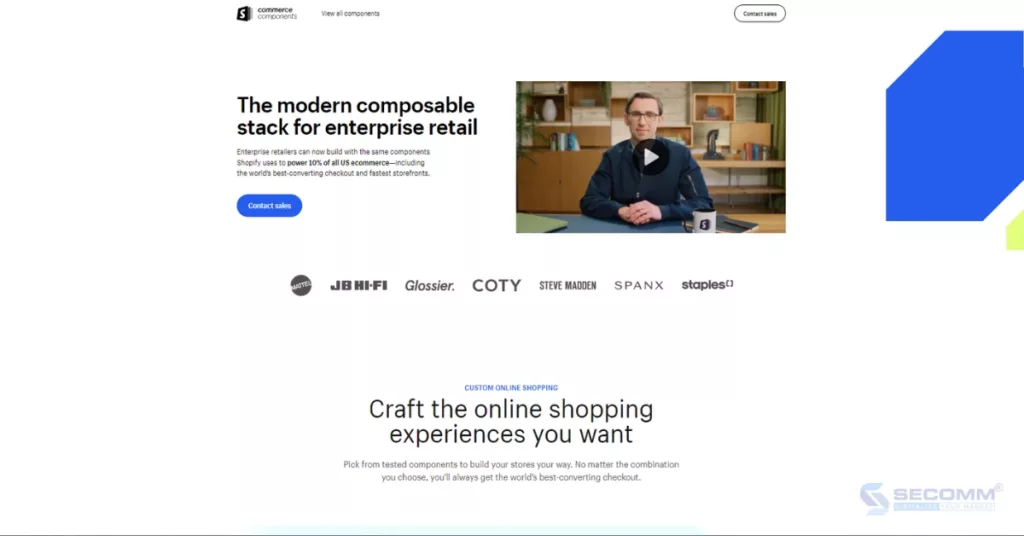
The solution offers six main categories including over 30 components, allowing you to build a tailored solution that aligns with your needs.


Although both ‘Plus’ and Components are enterprise eCommerce solutions, they differ in several aspects:
If you don’t prefer to deploy pre-packaged eCommerce platforms. Composable architecture is the ideal choice. It allows you to select and purchase components based on your needs, integrate them into your existing systems, and customize them.
With its modular architecture, the tech stack provides unlimited API connections, meaning there is no limit to the number of components and add-ons that you can use to build your tech stack.
Moreover, since components are entirely independent, you can add, remove, and modify components without affecting the entire system.
Commerce Components employs a pricing model structured around the level and quantity of components used. This means you only pay for the components you require. Furthermore, as you acquire and utilize more components, you’ll benefit from increasingly significant discounts.
Additionally, the annual payment structure of Components helps you facilitate precise cost predictions.
Since its inception, the platform has proudly highlighted the trust and adoption of its solution by major global businesses. Notable among these are Glossier, JB Hi-Fi, Coty, Steve Madden, Spanx, and Staples.

Leading U.S. toy brand Mattel is one of the first enterprises to successfully implement this technology solution. Sven Gerjets, Mattel’s CTO, said in a statement.
“We first worked with Shopify on a project called Mattel Creations, a platform for creators to reimagine the most iconic toys in the world. Creations empowered Mattel to move quickly, meet our customers where they are, and most importantly leverage its infrastructure to scale globally. It was hugely successful, and we’re excited to transform our brand offerings using Commerce Components.”
The trust placed by Mattel and other industry leaders forms a solid basis for expecting the ongoing success of this new solution, extending its impact not only within the U.S. market but also on a global scale.
Final Thoughts
In the past, large businesses often favored open-source platforms like Magento or Salesforce due to their customizable and flexible expansion capabilities. However, in today’s landscape, SaaS platforms, particularly Shopify, offer innovative solutions for developing Composable or Headless Commerce.
In 2021, the company launched the Hydrogen + Oxygen solution to enhance Headless Commerce development. Continuing this trend into early 2023, they once again surprise the industry with Commerce Components, designed for deploying Composable Commerce.
This move highlights its commitment to anticipating and responding to customer needs, earning the trust of large enterprises in the face of competitive rivals.
Reach out or call the SECOMM hotline at 028 7108 9908 for a more in-depth understanding of Commerce Components by Shopify and to explore the implementation of Headless Commerce or Composable Commerce.
 2
2
 11,189
11,189
 0
0
 1
1
In today’s eCommerce landscape, it isn’t just open-source platforms that can meet the complex development and customization needs of large-scale enterprises, but SaaS platforms are also steadily rising with significant improvements. Among them, two SaaS platforms designed specifically for large enterprises are Shopify Plus and BigCommerce Enterprise.
However, these two platforms have many key differences. This article aims to clarify the pros and cons of each platform and compare the differences between the two platforms to help you — as a business leader — make well-informed decisions.
Learn more: Shopify vs BigCommerce: Which platform is right for you?


Both platforms are recognized for their user-friendliness compared to open-source platforms. Their intuitive dashboard and user-friendly navigation, along with features like drag-and-drop editing, extensive documentation, and 24/7 support, make them accessible for users of varying technical expertise.
However, Shopify, known for its inherent user-friendly design, ensures that users, whether using the Plus version or the regular ones, can easily explore and set up their eCommerce website with efficiency.
Both these two premium solution platforms — which are Shopify Plus and BigCommerce Enterprise — cater to the deployment needs of large enterprises, these platforms offer advanced features and technologies that require some learning.
For example, the ‘Plus’ users need to grasp the Liquid template language, while those opting for the ‘Enterprise’ may benefit from understanding the Google Cloud Platform for optimizing website performance.
BigCommerce, renowned for its built-in features, continues this trend with the ‘Enterprise’ version. Some features may suit specific businesses but might be unnecessary for others. While BigCommerce allows flexibility for customizing and configuring these advanced features, it can introduce complexity and intricacy into the setup process.
Similarly to other premium solutions on SaaS platforms, the license fee will depend on the deployment requirements and the current scale of the business. BigCommerce doesn’t disclose the fee publicly, requiring businesses to directly contact the platform for tailored consultation and pricing.
On the other hand, Shopify Plus has a license fee starting at $2000 per month. Once you reach a monthly revenue threshold of $800,000, the platform fee becomes revenue-based, amounting to 0.25% of monthly revenue, capped at $40,000 per month or $480,000 per year.
Considering transaction fees is also important. While BigCommerce doesn’t charge transaction fees, Shopify Plus charges a 0.15% transaction fee for not using Shopify Payments.
To estimate deployment costs effectively, you should partner with development agencies and engage in detailed consultations with BigCommerce or Shopify for comprehensive guidance.

For large enterprises, the multi-store management feature is crucial and a primary consideration when selecting an eCommerce platform to sell globally. To engage in sales across various markets worldwide, your eCommerce website needs to be crafted to suit the preferences of each target audience in different markets.
This involves addressing issues related to language conversion, currency units, and payment methods with flexibility. Moreover, stores should be administered efficiently in a centralized manner rather than separately.
Shopify Plus allows you to create up to 9 additional storefronts alongside the main storefront at 1000 different inventory locations and 20 additional inventory locations. All these storefronts can be centrally managed through a single dashboard.
Plus, the Shopify Market feature will help you select the markets you want to sell in. The system will then automatically convert and manage multiple languages, currency units, shipping options, and payment methods based on the user’s IP address. Currently, Shopify Plus supports a range of local payment gateways, and you can refer to the provided list.

BigCommerce Enterprise doesn’t provide many solutions or features for global selling. Instead, it allows you to deploy multiple stores within the platform and then integrate with 3rd-party PIM solutions to manage data across these stores.
Another option is to leverage the BigCommerce Stencil framework to tailor content language for each local market. Also, the Enterprise version supports multi-currency payments through more than 250 local payment gateways.
The demand for adopting Headless eCommerce is on the rise, especially among large enterprises seeking to deliver a seamless and optimized experience for their customers. Both Shopify Plus and BigCommerce Enterprise offer effective solutions for going Headless.
BigCommerce Enterprise allows you to integrate with various frameworks (Next.js, Gatsby.js, Nuxt.js), APIs (REST, GraphQL), and your preferred or previously used tools.
When using Shopify Plus, there are three approaches. You can use the Storefront API to connect and develop with your preferred frameworks, hosting solutions, and tools. Or, you can leverage Shopify Hydrogen framework and Oxygen hosting to facilitate a headless eCommerce website flexibly.
Just like their regular pricing plans, both the ‘Enterprise’ and the ‘Plus’ include Point of Sale (POS) features for eCommerce transactions, catering to both online and offline stores, as well as Omnichannel operations.
POS can be configured on various devices like mobile devices (tablets, smartphones), and other hardware like cash registers and barcode scanners.
BigCommerce Enterprise offers smooth integration with third-party POS systems like Square, Vend, Clover, and Heartland Retail. It’s good for those who already using POS software from these third-party providers.

For Shopify Plus, beyond the option to integrate with third-party POS systems like BigCommerce Enterprise (Clover, Square, Zend), Shopify offers its own Shopify POS solution, available in two plans:

Both ‘Plus’ and ‘Enterprise’ offer tools and solutions to help you automate your eCommerce website operations.
Shopify Plus offers an exclusive solution, Shopify Flow, and LaunchPad, allowing you to automate routine tasks and set up automated workflows for tasks like email marketing campaigns or new product launches.
On the other hand, BigCommerce Enterprise takes a different automation approach which enables you to smoothly integrate with 3rd-party apps. Some of them are HubSpot, Avalara, ShipStation, etc.
SEO plays a crucial role in improving the search visibility of an eCommerce site and attracting potential customers. Both platforms offer features to enhance SEO efforts.
The ‘Plus’ stands out for its user-friendly interface and an integrated app ecosystem that can enhance SEO, incorporating tools such as Google Search Console and Analytics. However, it comes with limitations in URL control and customization.
The ‘Enterprise’, on the other hand, provides more versatile SEO capabilities, including complete control over URLs and integration with applications like Google Search Console and Analytics. It makes the process more intricate compared to Shopify Plus, involving additional setup operations.
Shopify Plus offers businesses approximately 12 free themes and 147 paid themes, with prices ranging from $150 to $380 per theme. On the other hand, BigCommerce Enterprise provides around 12 free themes and 185 paid themes, with prices ranging from $150 to $400 per theme.
Both platforms offer a wide range of visually appealing and mobile-friendly theme options. While the ‘Enterprise’ themes are characterized by elegant, tidy, and modern designs with highly customizable features, the ‘Plus’ themes can meet higher requirements for user experience, making navigation easier.

To facilitate efficient eCommerce deployment, the two provide vast app stores and extensions, tailored for ‘Plus’ and ‘Enterprise’ businesses. While both platforms offer free versions, access to comprehensive features requires a modest monthly fee.
Shopify Plus boasts over 6,000 apps and extensions, while BigCommerce Enterprise has around 1,000. This can be explained by Shopify’s widespread popularity among businesses and developers globally, providing them with ample documentation and resources for app and extension development, including the Shopify Plus Certified App Program.
For businesses that are ready to deploy the ‘Plus’ or the ‘Enterprise’ solutions, the demand for technical support and efficient eCommerce website operations is significant.
Both platforms receive high praise for their customer service. They offer 24/7 support via hotline, email, and video available in multiple languages. However, if you need specialized and complex technical support, Shopify Plus may be the preferable choice.
Final Thoughts
In the competitive business landscape, selecting the right platform for launching an eCommerce website is an important decision. Both Shopify Plus and BigCommerce Enterprise offer distinct advantages and cater to various business models.
Regardless of the platform chosen, you should prioritize the development and delivery of an exceptional shopping experience for your customers. eCommerce platforms serve as tools, and the ultimate key to success lies in an effective deployment strategy and great collaboration with a proficient team.
With extensive experience helping numerous businesses deploy diverse eCommerce development projects on both Shopify Plus and BigCommerce Enterprise, SECOMM boasts a team of seasoned experts capable of collaborating to create exceptional eCommerce experiences and help you enhance your brand positioning.
Reach out or directly call the hotline at 028 7108 9908 to explore how SECOMM can contribute to optimizing the potential of Shopify Plus and BigCommerce Enterprise for enduring your business success.
 2
2
 7,177
7,177
 0
0
 1
1
Baby eCommerce is a promising market experiencing a steady annual growth rate (CAGR 2023-2027) of 9.86%, projected to reach a market value of approximately USD 129.40 billion by 2027.
To tap into this market, you’ll need to develop a professional and efficient eCommerce website. Here are 10 steps to create an eCommerce website tailored for maternity and baby products.
The first step is to identify your business goals and prioritize them, forming a plan tailored to develop an effective Baby eCommerce website.
Concerning long-term goals, you may focus on objectives like establishing a strong brand presence, reaching potential customers, and enhancing the efficiency of both online and offline operations.
For short-term goals, businesses can give priority to activities like monitoring, analyzing customer behavior, assessing the effectiveness of marketing campaigns, and boosting revenue.
When it comes to timeline, you can decide to deploy quickly to enter the market or proceed gradually to test and adapt to this eCommerce world.
As for the budget, it depends on your business strategy and financial capacity for this Baby eCommerce development project.
Currently, there are two types of eCommerce platforms to help you build your first Baby website: SaaS (Software as a Service) and Open-Source platform.
Some popular SaaS eCommerce platforms include Shopify, BigCommerce, Squarespace, and Wix.

In addition, there are premium versions of these SaaS platforms such as Shopify Plus, BigCommerce Enterprise, and Goflow.

Some open-source platforms are widely used: Adobe Commerce (Magento), WooCommerce, OpenCart, and PrestaShop.

Typically, some new businesses choose basic SaaS platforms to save time and budget in the initial phase of the Baby eCommerce website development. After a while, they may switch to a premium SaaS or an open-source platform to develop their baby websites more advanced.
In another case, some businesses opt for open-source platforms to build a basic eCommerce website and then gradually upgrade the system over time to minimize the need for platform switching in later phases.
Typically, most eCommerce businesses decide to initially partner with a professional development agency and gradually build their in-house team.
For establishing an in-house team, you’ll need to recruit and train IT and eCommerce professionals for expertise on the chosen platform. It’ll take you significant time and budget but allow you to have full control over your resources. You can develop and adjust your Baby eCommerce website according to your needs and wants.

When it comes to partnering with an agency, here are some criteria you need to evaluate:
Partnering with a professional development agency gains you specialized eCommerce knowledge, enhances your technical skills, and above all, you’ll facilitate the eCommerce website exactly what you need, tailoring it to the unique features of the maternity and baby industry.
When it comes to UI/UX design, it’s important to showcase the brand image, products, user guide, etc. There are three popular ways to make your design:
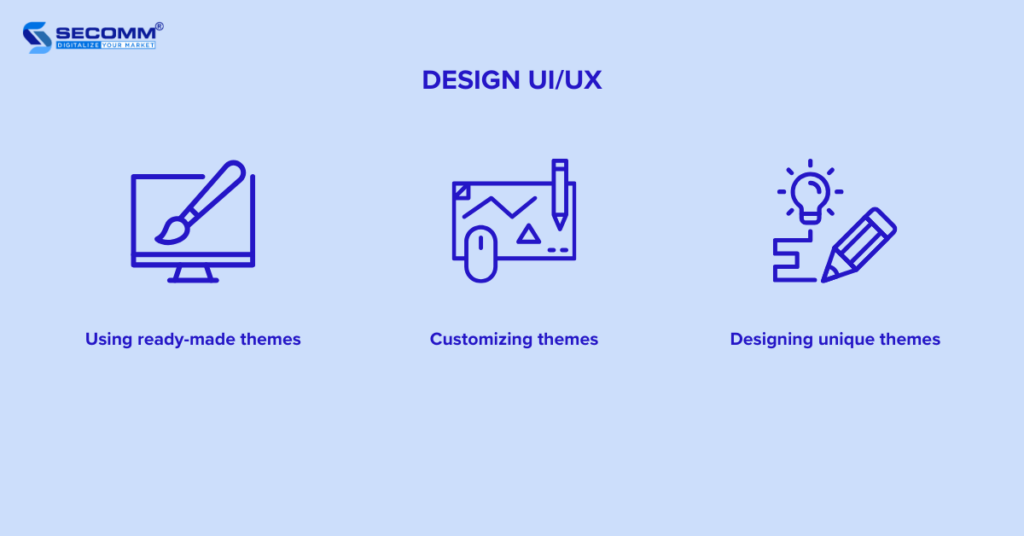
Some essential features that a Baby eCommerce website should have include
Some advanced features for the baby eCommerce industry:

After developing features and ensuring a successful testing and website launch, you’ll need to complete the legal procedures associated with eCommerce operations.
According to Decree 52/2013/ND-CP by the Government of Vietnam, any individual or organization owning an eCommerce website for sales is required to notify or register with the Ministry of Industry and Trade through the online public service portal of the Ministry of Industry and Trade.
Note: Websites that operate beyond the specified period or fail to register/notify the authorized management agency within the designated timeframe may be subject to administrative penalties as per regulations.
When QC/testing your eCommerce website, you can leverage either the Waterfall or Agile model to test the entire system.

Using these models helps you review and test your entire eCommerce system, functions, and features within a specified timeframe, ensuring optimal order processing speed and overall website stability. In case of any issues, your in-house team or development partner will help you to address them before officially going live.
When the QC/testing process is done, your baby eCommerce website is ready to launch. To ensure a smooth go-live process, here are three steps you should prepare:

Running a baby website is an ongoing effort aimed at ensuring the steady and effective functioning of the system. This involves various activities, including:
Furthermore, you should regularly maintain, update, and upgrade the website system to achieve sustainable growth, adapting quickly to shifts in the eCommerce world or the maternity and baby products market.

After a period of operation, you should shift your focus toward eCommerce marketing strategies or Omnichannel to expand your online presence in the market of maternity and baby products
businesses should redirect their focus toward implementing eCommerce marketing strategies or embracing Omnichannel approaches to expand their online presence in the market of mother and baby products.
Implementing Omnichannel involves setting up a seamless sales, marketing, and management system across channels such as the website, social media platforms (Facebook, Instagram, Zalo, TikTok Shop), and online marketplaces (Shopee, Tiki, Lazada, Sendo) to optimize the customer experience and boost business efficiency.
Developing a comprehensive marketing strategy, centered around key eCommerce marketing channels like Content Marketing, SEO/SEM, Email Marketing, and Affiliate Marketing, becomes crucial for achieving rapid sales growth.
The Bottom Line
In general, the journey of building a baby eCommerce website for the Vietnamese market isn’t an easy task. It requires you to invest a significant amount of time and budget in researching the most fitting strategies tailored to each phase of your eCommerce development.
Understanding the difficulties and challenges that businesses may encounter when building a baby eCommerce website, SECOMM is ready to provide free consultation on detailed eCommerce solutions.
Reach out or call the SECOMM hotline at 028 7108 9908 to get started!
 2
2
 6,009
6,009
 0
0
 1
1Subscribe to get the latest eBook!
Hotline